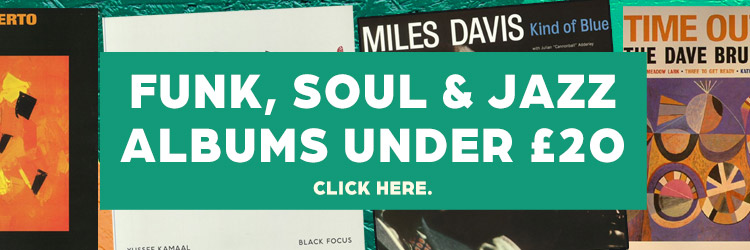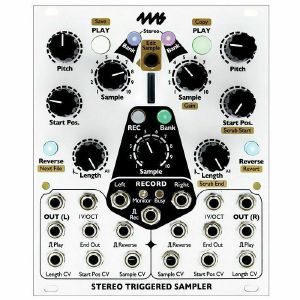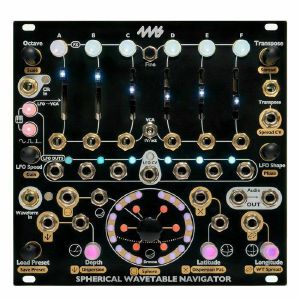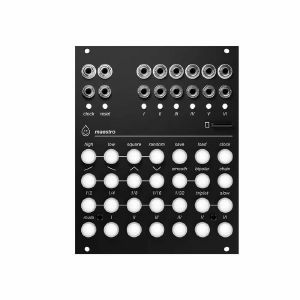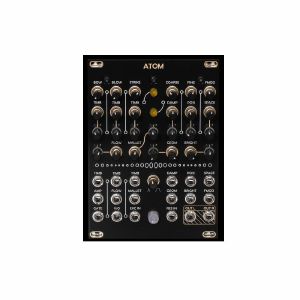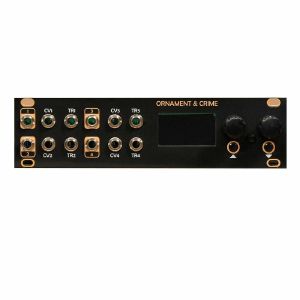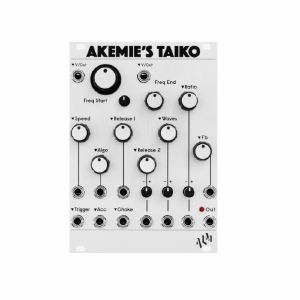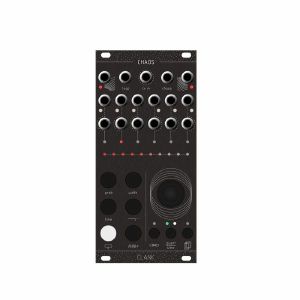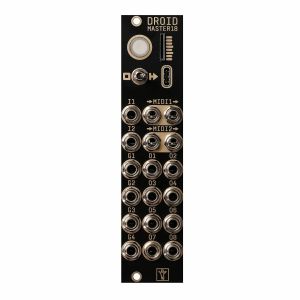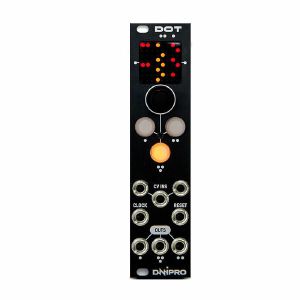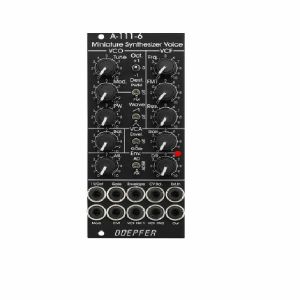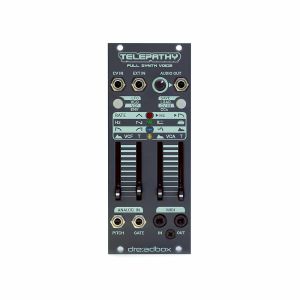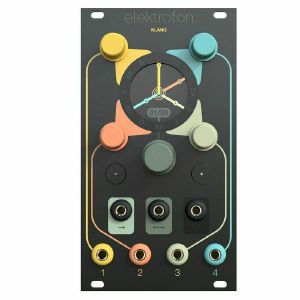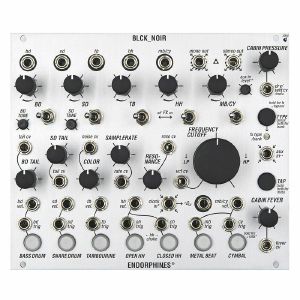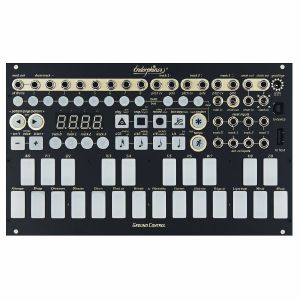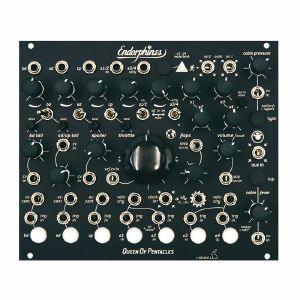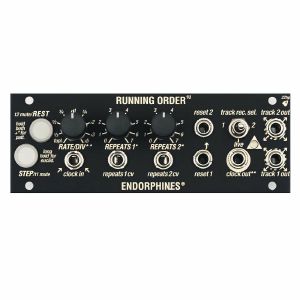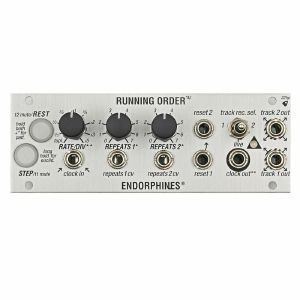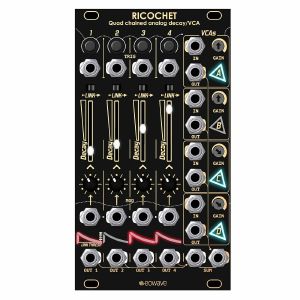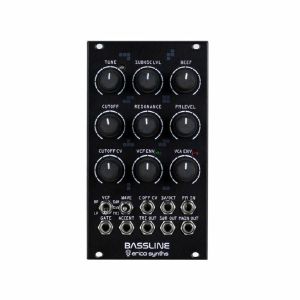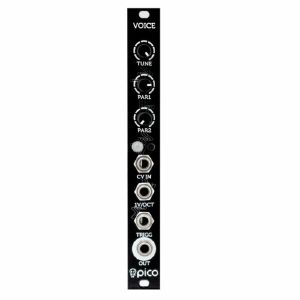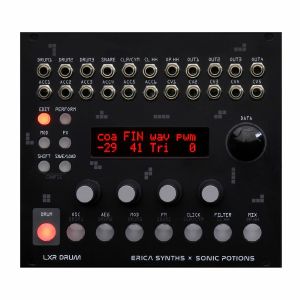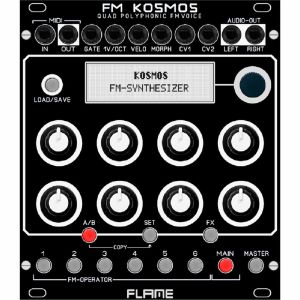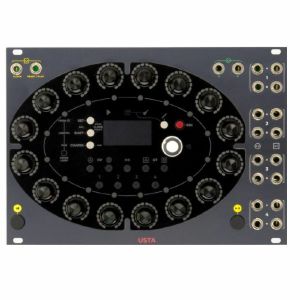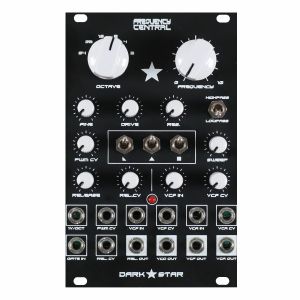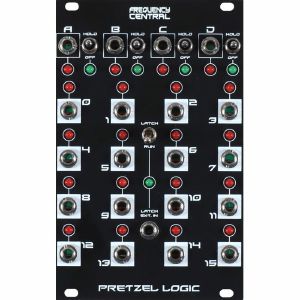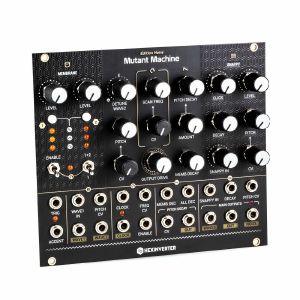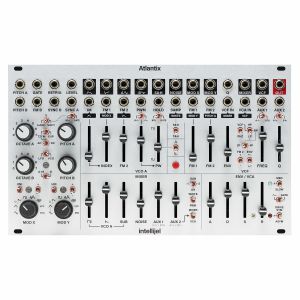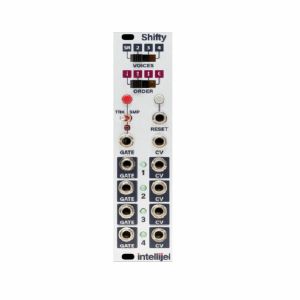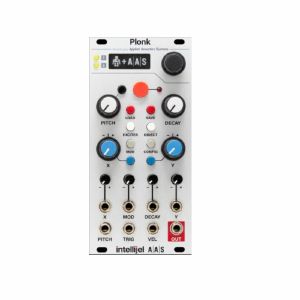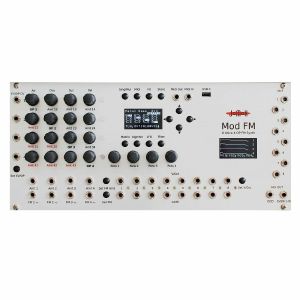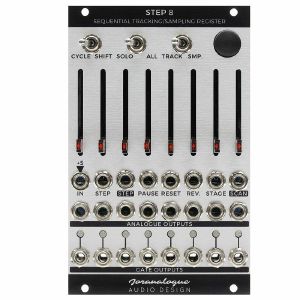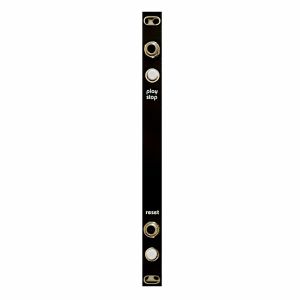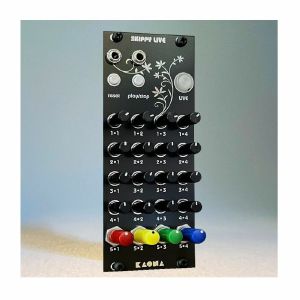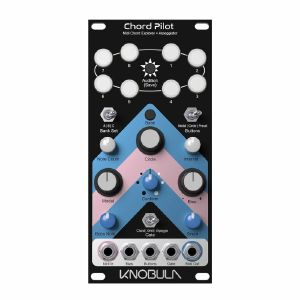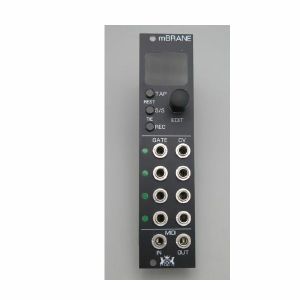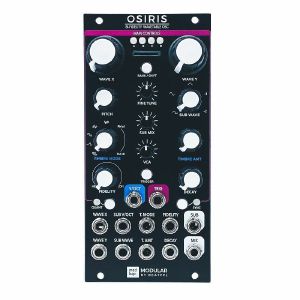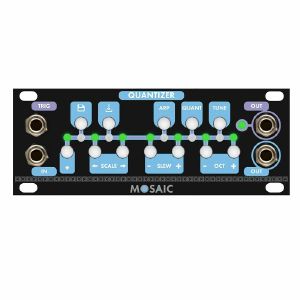Back catalogue: All genres
Juno's full catalogue of All genres4ms MetaModule Virtual Patch Player Module (modular synthesiser)
Cat: 1025842 Rel: 28 Aug 24
Virtual patch player module - 26HP
Notes: The hands-on control of hardware meets the versatility of software. Bridging the gap between Eurorack and VCV Rack, the MetaModule includes over 160 built-in modules plus access to over 200 third-party options.
Supplier's Notes:
The MetaModule puts real knobs and jacks on virtual software modules. Step back from the computer and make music with hardware, while keeping the flexibility and expandability of software.
The MetaModule comes with over 160 built-in modules from 4ms Company, Befaco, HetrickCV, NonlinearCircuits, and Scanner Darkly, plus clones of popular classics such as the Mutable Instruments eurorack modules, fun physical modeling algorithms, and lots of handy utilities.
All of the included modules are also available on the computer using the free program VCV Rack. Whether you make patches on VCV Rack and transfer them to the MetaModule, or if you just create patches directly on the MetaModule, there are plenty of creative modules to inspire new ways to make music.
MetaModule Plugins
If the 160+ built-in module aren't enough, you can load more modules as plugins. Already there are over 200 modules in third-party plugins from Bogaudio, Valley, ChowDSP, NANO Modular, and the list is growing. 4ms have an SDK available to make it easy for VCV Rack plugin developers to convert their plugin to a MetaModule plugin. 4ms' licensing terms are non-restrictive: developers are welcome to distribute their plugin in any way they wish, commercially or not.
Mapping Knobs and Jacks
The MetaModule has 12 knobs that can be mapped to virtual knobs. Each knob can be mapped to up eight virtual knobs, and each mapping can have a different range and offset. You also can save a group of mappings as a Knob Set and switch between Knob Sets with the encoder. You also can map the 8 inputs and 8 outputs to virtual module jacks. Also, the MetaModule is a USB MIDI host, so you also can map MIDI CC, note, gate, and other parameters to knobs and jacks.
Expanders
There are lots of ways to customize your MetaModule. A Wifi expander allows you to wirelessly transfer patches from your computer. Add eight more knobs with the Knob expander, or buttons with the Button expander. A CV/Audio expander adds more high-resolution inputs and outputs, and the Gate In/Out expander adds not only gate jacks but also TRS MIDI and I2C.
Under the Hood
There are six CV/Audio inputs, two gate inputs, and six CV/Audio outputs. The CV/Audio jacks are all 24-bit, 48kHz DC-coupled, -10V to +10V. A USB-C jack accepts MIDI devices and thumb drives. Patches and plugins can be loaded via a USB drive or microSD Card, and internal flash memory lets you save patches you always want to come back to.
The processor is more advanced than anything 4ms has used in the past, and is among the most powerful processors found in Eurorack. Startup time and latency are blazingly fast.
Modules
160 built-in modules
Over 200 3rd-party module plugins available so far, and the ecosystem is growing
Create patches using VCV Rack or directly on MetaModule
Patches
Patches are loaded from microSD Card, USB drive, or via the Wifi expander
Patches can be optionally saved onto internal flash memory
Create patches using VCV Rack or directly on MetaModule
Patches can be given a name and description
Mappings
Map each physical knob to up to 8 virtual knobs
Set range and offset for each mapping, including inverted control
Knob mappings are grouped into Knob Sets, and changing Knob Sets can be done quickly without menu-diving
Map physical jacks to virtual jacks, seamlessly making splits/mults
Add or edit modules, cables, and mappings in real-time while the patch is playing
Create alias names for mappings like "Kick Drum Level"
Interface
Simple, intuitive graphical interface lets you zoom in on details, or zoom out to get a big picture
Patch View displays the patch as faceplates and cables, with knobs, buttons, and lights animating in real-time
Knob Set View simplifies the display, showing only the mapped knobs for the current Knob Set
Module View shows just one module and lists the names of each jack, knob, and control legibly
Mapping View lets you adjust details of a knob mapping
Adjust styles and visual preferences to your liking
Save, rename, duplicate, and delete patches
Firmware updater and plugin loader read from microSD Card or USB drive
Hardware
12 Knobs
8 CV/Audio outputs, 24-bit 48kHz, -10V to +10V, DC-coupled
6 CV/Audio inputs, 24-bit 48kHz, -10V to +10V, DC-coupled
2 Gate inputs
USB-C jack: MIDI Host or MSC (External drive) Host
microSD Card slot
Internal Flash RAM for additional patch storage
Dual-core 800MHz Cortex-A7 plus Cortex-M4 co-processor
512MB DDR3 533MHz RAM
Bare-metal operation for fast startup and low latency
26hp
… Read moreSupplier's Notes:
The MetaModule puts real knobs and jacks on virtual software modules. Step back from the computer and make music with hardware, while keeping the flexibility and expandability of software.
The MetaModule comes with over 160 built-in modules from 4ms Company, Befaco, HetrickCV, NonlinearCircuits, and Scanner Darkly, plus clones of popular classics such as the Mutable Instruments eurorack modules, fun physical modeling algorithms, and lots of handy utilities.
All of the included modules are also available on the computer using the free program VCV Rack. Whether you make patches on VCV Rack and transfer them to the MetaModule, or if you just create patches directly on the MetaModule, there are plenty of creative modules to inspire new ways to make music.
MetaModule Plugins
If the 160+ built-in module aren't enough, you can load more modules as plugins. Already there are over 200 modules in third-party plugins from Bogaudio, Valley, ChowDSP, NANO Modular, and the list is growing. 4ms have an SDK available to make it easy for VCV Rack plugin developers to convert their plugin to a MetaModule plugin. 4ms' licensing terms are non-restrictive: developers are welcome to distribute their plugin in any way they wish, commercially or not.
Mapping Knobs and Jacks
The MetaModule has 12 knobs that can be mapped to virtual knobs. Each knob can be mapped to up eight virtual knobs, and each mapping can have a different range and offset. You also can save a group of mappings as a Knob Set and switch between Knob Sets with the encoder. You also can map the 8 inputs and 8 outputs to virtual module jacks. Also, the MetaModule is a USB MIDI host, so you also can map MIDI CC, note, gate, and other parameters to knobs and jacks.
Expanders
There are lots of ways to customize your MetaModule. A Wifi expander allows you to wirelessly transfer patches from your computer. Add eight more knobs with the Knob expander, or buttons with the Button expander. A CV/Audio expander adds more high-resolution inputs and outputs, and the Gate In/Out expander adds not only gate jacks but also TRS MIDI and I2C.
Under the Hood
There are six CV/Audio inputs, two gate inputs, and six CV/Audio outputs. The CV/Audio jacks are all 24-bit, 48kHz DC-coupled, -10V to +10V. A USB-C jack accepts MIDI devices and thumb drives. Patches and plugins can be loaded via a USB drive or microSD Card, and internal flash memory lets you save patches you always want to come back to.
The processor is more advanced than anything 4ms has used in the past, and is among the most powerful processors found in Eurorack. Startup time and latency are blazingly fast.
Modules
160 built-in modules
Over 200 3rd-party module plugins available so far, and the ecosystem is growing
Create patches using VCV Rack or directly on MetaModule
Patches
Patches are loaded from microSD Card, USB drive, or via the Wifi expander
Patches can be optionally saved onto internal flash memory
Create patches using VCV Rack or directly on MetaModule
Patches can be given a name and description
Mappings
Map each physical knob to up to 8 virtual knobs
Set range and offset for each mapping, including inverted control
Knob mappings are grouped into Knob Sets, and changing Knob Sets can be done quickly without menu-diving
Map physical jacks to virtual jacks, seamlessly making splits/mults
Add or edit modules, cables, and mappings in real-time while the patch is playing
Create alias names for mappings like "Kick Drum Level"
Interface
Simple, intuitive graphical interface lets you zoom in on details, or zoom out to get a big picture
Patch View displays the patch as faceplates and cables, with knobs, buttons, and lights animating in real-time
Knob Set View simplifies the display, showing only the mapped knobs for the current Knob Set
Module View shows just one module and lists the names of each jack, knob, and control legibly
Mapping View lets you adjust details of a knob mapping
Adjust styles and visual preferences to your liking
Save, rename, duplicate, and delete patches
Firmware updater and plugin loader read from microSD Card or USB drive
Hardware
12 Knobs
8 CV/Audio outputs, 24-bit 48kHz, -10V to +10V, DC-coupled
6 CV/Audio inputs, 24-bit 48kHz, -10V to +10V, DC-coupled
2 Gate inputs
USB-C jack: MIDI Host or MSC (External drive) Host
microSD Card slot
Internal Flash RAM for additional patch storage
Dual-core 800MHz Cortex-A7 plus Cortex-M4 co-processor
512MB DDR3 533MHz RAM
Bare-metal operation for fast startup and low latency
26hp
2 in stock $606.41
Click for better price!
or call +44 20 7424 1960
quote 1025842
quote 1025842
4ms Stereo Triggered Sampler Recorder & Playback Module (sampling/digital/dual/stereo/oscillator/synth voice synth module)
Cat: 655465 Rel: 29 Aug 17
High fidelity, two-channel stereo sample recorder & playback module
Notes: The Stereo Triggered Sampler can record high quality stereo files, while simultaneously playing two different stereo files. A maximum of 600 samples can be loaded from the removable/swappable microSD card, in a variety of formats up to 96kHz/32-bit/stereo WAV. All sample parameters (1V/oct pitch, sample file selection, length, and start position) are CV controllable.
600 Samples:
A maximum of 600 samples can be loaded at once, arranged into banks of 10 samples each. Samples and banks can be re-arranged on the fly using the simple on-board Edit features. Newly recorded samples can be instantly played back and re-pitched, reversed, chopped up, etc... the result of which can even be bounced down and re-recorded to as a new sample! Sample files are limited to 4GB each, which is over 6 hours at 44k/16b/stereo.
Two Stereo Playback Channels:
Each playback channel has a knob and CV jack for Sample File selection, as well as a Start Position knob and CV jack for controlling where in the sample playback will begin. The Length knob and CV jack determine how much of the sample is played back: from tiny grains, to percussive hits, to longer loops... or just the entire file. These are powerful tools for re-arranging a sample, joining multiple samples, and creating dynamically re-sized loops within a larger sample. Combined with the Play Trigger jack and the 1V/oct jack, the STS can be two complete multi-timbral pitch-tracked stereo voices!
There's also a Reverse button and jack for backwards playback, and an End Out jack for synchronizing loops, or cascading sample playback with other events.
Looping and Sync:
Looping is easy: just hold the PLAY button down for two seconds to toggle loop or one-shot. The loop timing clock will output from the End Out jack. Or, send a clock into the Play Trig jack to sync the loop to external timing.
Stereo Recording:
Whether you patched 47 modules to create the ultimate percussive blast, or you want to capture your four hour ambient performance, recording high-quality .wav files on the STS is simple. Just hit the REC button or fire a trigger and a new stereo .wav file will be created on the SD card. Do as many takes as you need: the STS never deletes your files. Re-ordering or re-arranging samples into banks is easy, even without a computer.
You can even fill a bank with 10 different variations and immediately use them for playback.
By default the STS records at 44.1kHz/16-bit, with an option for 24-bit (a future update may increase the sample rate to 96kHz)
Easy sample loading:
Using a computer is completely optional with the STS, since samples can be recorded directly to the module and placed into the bank of your choosing. But for users with large existing sample banks, the intuitive automatic bank loading features make dragging and dropping your entire sample library a snap. You never have to rename your files again!
… Read more600 Samples:
A maximum of 600 samples can be loaded at once, arranged into banks of 10 samples each. Samples and banks can be re-arranged on the fly using the simple on-board Edit features. Newly recorded samples can be instantly played back and re-pitched, reversed, chopped up, etc... the result of which can even be bounced down and re-recorded to as a new sample! Sample files are limited to 4GB each, which is over 6 hours at 44k/16b/stereo.
Two Stereo Playback Channels:
Each playback channel has a knob and CV jack for Sample File selection, as well as a Start Position knob and CV jack for controlling where in the sample playback will begin. The Length knob and CV jack determine how much of the sample is played back: from tiny grains, to percussive hits, to longer loops... or just the entire file. These are powerful tools for re-arranging a sample, joining multiple samples, and creating dynamically re-sized loops within a larger sample. Combined with the Play Trigger jack and the 1V/oct jack, the STS can be two complete multi-timbral pitch-tracked stereo voices!
There's also a Reverse button and jack for backwards playback, and an End Out jack for synchronizing loops, or cascading sample playback with other events.
Looping and Sync:
Looping is easy: just hold the PLAY button down for two seconds to toggle loop or one-shot. The loop timing clock will output from the End Out jack. Or, send a clock into the Play Trig jack to sync the loop to external timing.
Stereo Recording:
Whether you patched 47 modules to create the ultimate percussive blast, or you want to capture your four hour ambient performance, recording high-quality .wav files on the STS is simple. Just hit the REC button or fire a trigger and a new stereo .wav file will be created on the SD card. Do as many takes as you need: the STS never deletes your files. Re-ordering or re-arranging samples into banks is easy, even without a computer.
You can even fill a bank with 10 different variations and immediately use them for playback.
By default the STS records at 44.1kHz/16-bit, with an option for 24-bit (a future update may increase the sample rate to 96kHz)
Easy sample loading:
Using a computer is completely optional with the STS, since samples can be recorded directly to the module and placed into the bank of your choosing. But for users with large existing sample banks, the intuitive automatic bank loading features make dragging and dropping your entire sample library a snap. You never have to rename your files again!
1 in stock $423.81
Click for better price!
or call +44 20 7424 1960
quote 655465
quote 655465
4ms SWN Spherical Wavetable Navigator 6-Channel Synthesiser Module (black) (oscillator/digital/LFO/synth voice synth module)
Cat: 648377 Rel: 29 Apr 19
Six-channel synthesiser module - 26HP
Notes: The Spherical Wavetable Navigator (SWN) is a six-channel synthesiser that makes it easy to create slowly morphing drones, polyphonic melodies, evolving sequences, and rich textures.
The SWN features six wavetable oscillators with independent pitch, level, and waveform controls. Six LFOs (Low Frequency Oscillators) can be used as modulation sources and/or envelopes, making it easy to add dynamic motion to your patch. Each channel is a full voice and can be "played" using the top row of buttons, the internal LFOs, or note-change detection on the 1V/oct jacks. The SWN ships with 12 three-dimensional (spherical) wavetables and an easy interface which allows you to record and edit custom wavetables from live audio. Open-source software for Mac, Windows, and Linux called SphereEdit can be freely downloaded and allows you computer to create, edit, and convert .wav files into Spherical wavetables to transfer into the SWN with an audio cable.
New firmware available which adds extra features, visit https://4mscompany.com/p.php?p=820&c=5 for details.
… Read moreThe SWN features six wavetable oscillators with independent pitch, level, and waveform controls. Six LFOs (Low Frequency Oscillators) can be used as modulation sources and/or envelopes, making it easy to add dynamic motion to your patch. Each channel is a full voice and can be "played" using the top row of buttons, the internal LFOs, or note-change detection on the 1V/oct jacks. The SWN ships with 12 three-dimensional (spherical) wavetables and an easy interface which allows you to record and edit custom wavetables from live audio. Open-source software for Mac, Windows, and Linux called SphereEdit can be freely downloaded and allows you computer to create, edit, and convert .wav files into Spherical wavetables to transfer into the SWN with an audio cable.
New firmware available which adds extra features, visit https://4mscompany.com/p.php?p=820&c=5 for details.
1 in stock $563.57
Click for better price!
or call +44 20 7424 1960
quote 648377
quote 648377
Acid Rain Technology Maestro 6-Channel Clocked Modulation Controller Module (clock generator/clock modulator/controller/CV modulation/envelope generator/LFO/random/sequencer module)
Cat: 804571 Rel: 22 Jan 21
6-channel clocked modulation module
Notes: Maestro is a 6 channel clocked modulation controller inspired by the automation lanes found in digital audio workstation software, brought into eurorack and made playable and performable. Maestro will push and pull the parameters of your other modules with rapid or slowly evolving voltages, always in perfect sync with eachother and the rest of your system.
Details:
20hp
25mm deep
65mA on +12, 18mA on -12, 0mA on 5V
… Read moreDetails:
20hp
25mm deep
65mA on +12, 18mA on -12, 0mA on 5V
1 in stock $400.14
Click for better price!
or call +44 20 7424 1960
quote 804571
quote 804571
After Later Audio Alan Random Looping Sequencer Module (CV modulation/random/sequencer synth module)
Cat: 805272 Rel: 14 Jan 21
Register-based sequencer module
Notes: Alan (micro Turing Machine) Shift Register Based Sequencer
The randomness of the Music Thing Modular Turing Machine, shrunk down to 6HP. Alan retains all of the same functionality as the original including the connectors for the expanders.
While this module has little to do with the original Turing Machine (by Alan Turing), it is a shift register based sequencer. You cannot program this sequencer, instead it builds random sequences that can be locked in.
Alan comes tested, calibrated and ready to bring random voltages.
The After Later Audio panel is black and gold and made from FR4. The package will include a power/ribbon cable and a one year warranty.
… Read moreThe randomness of the Music Thing Modular Turing Machine, shrunk down to 6HP. Alan retains all of the same functionality as the original including the connectors for the expanders.
While this module has little to do with the original Turing Machine (by Alan Turing), it is a shift register based sequencer. You cannot program this sequencer, instead it builds random sequences that can be locked in.
Alan comes tested, calibrated and ready to bring random voltages.
The After Later Audio panel is black and gold and made from FR4. The package will include a power/ribbon cable and a one year warranty.
1 in stock $189.35
After Later Audio Atom Modal Synthesiser Module (synth voice module)
Cat: 805274 Rel: 14 Jan 21
Modal synthesiser module - 18HP
Notes: The full power of Mutable Instruments Elements packed into 18hp. It features jack lights that can be turned on/off via a jumper on the back. This module comes loaded with the most recent firmware, with the new Chords mode that unlocks a whole new world of potential.
Based on open source designs by emilie gillet under Creative Commons (CC-BY-SA) license.
Width: 18hp
12V: 130mA
-12V: 10mA
… Read moreBased on open source designs by emilie gillet under Creative Commons (CC-BY-SA) license.
Width: 18hp
12V: 130mA
-12V: 10mA
2 in stock $224.30
After Later Audio uGrids Grids Redesigned Module (clock generator/digital/drum/random/sequencer synth module)
Cat: 910123 Rel: 21 Nov 22
An 8hp version of the retired Mutable Instruments Grids.
Notes: An 8hp version of the retired Mutable Instruments Grids. It is an identical functional clone, so it will behave in the same was as the full size version, and will run any firmware that runs on the full size version.
… Read more 1 in stock $166.82
Click for better price!
or call +44 20 7424 1960
quote 910123
quote 910123
After Later Audio uO_C 1U Micro Ornament & Crime Polymorphic CV Generator Module (CV modulation/envelope generator/LFO/MIDI/quad/quantizer/random/utility module)
Cat: 862179 Rel: 02 Feb 22
Polymorphic CV generator module - 30HP
Notes: Ornament & Crime for 1U Intellijel format
This is functionally identical to the 3U version, just re-oriented to fit in 1U racks. Ornament & Crime is designed by mxmxmx.
The apps currently available in Ornament & Crime:
CopierMaschine is an enhanced version of the original quantising digital emulation of a four stage analogue shift register (ASR).
Harrington 1200 provides basic neo-Riemannian Tonnetz transformations of triadic chords, triggered by the digital (gate/trigger) inputs.
Automatonnetz combines Tonnetz transforms with a "vector" sequencer - it can be both a chord sequencer and a melody sequencer, but not of the usual kind.
Quantermain is a quad pitch quantiser for external voltages, with editable scales; it can do clocked (trigger-driven) quantising, or continuous quantising, with a latency of under 100 microseconds; it also features quad Turing Machines, May-Verhulst logistic maps or byte beats as optional, semi-random, internally generated CV sources.
Meta-Q is a dual-channel quantiser, similar to Quantermain, but also offering scale and note mask sequencing.
Quadraturia is a wavetable quadrature LFO, based on the "Easter egg" in the Mutable Instruments Frames module.
Low-rents is a dual Lorenz and Rossler (strange attractor) modulation generator, partially based on the "Easter egg" in the Mutable Instruments Streams module.
Piqued is a quad voltage-controlled envelope generator, based on envelope generator code from the Mutable Instruments Peaks module, but extending it with voltage control, additional envelope types, including re-triggering (looping) envelopes, additional segment shapes, adjustable trigger delays, and a unique Euclidean "trigger filter" which turns the app into a Euclidean rhythm generator which can output envelopes, not just gate or trigger pulses.
Sequins is a dual-channel step sequencer offering 4 "tracks" of up to 16 steps each; tracks can themselves be sequenced.
Dialectic Ping Pong is a quad bouncing ball envelope generator, based on a hidden mode of the Mutable Instruments Peaks module.
Viznutcracker, sweet! is a quad "byte beat" equation generator, which can be used as an audio source to generate curious but often interesting 8-bit noises and tunes, or which can be clocked by an external source to produce "byte beat" control voltage sequences. "Byte beats" were first described in 2011 by viznut (aka Ville-Matias Heikkila).
Acid Curds is both a chord quantiser (sometimes called a "harmonic quantiser" for external pitch voltages), and a chord progression sequencer.
References is an utility app that outputs specific reference voltages on each channel to help tune or calibrate VCOs and other modules. It also includes a high-precision frequency meter and note tuner, a high-precision BPM (beats per minute) tempo meter, and a closed-loop calibration mode.
Width: 30hp
12V: 85mA
-12V: 10mA
… Read moreThis is functionally identical to the 3U version, just re-oriented to fit in 1U racks. Ornament & Crime is designed by mxmxmx.
The apps currently available in Ornament & Crime:
CopierMaschine is an enhanced version of the original quantising digital emulation of a four stage analogue shift register (ASR).
Harrington 1200 provides basic neo-Riemannian Tonnetz transformations of triadic chords, triggered by the digital (gate/trigger) inputs.
Automatonnetz combines Tonnetz transforms with a "vector" sequencer - it can be both a chord sequencer and a melody sequencer, but not of the usual kind.
Quantermain is a quad pitch quantiser for external voltages, with editable scales; it can do clocked (trigger-driven) quantising, or continuous quantising, with a latency of under 100 microseconds; it also features quad Turing Machines, May-Verhulst logistic maps or byte beats as optional, semi-random, internally generated CV sources.
Meta-Q is a dual-channel quantiser, similar to Quantermain, but also offering scale and note mask sequencing.
Quadraturia is a wavetable quadrature LFO, based on the "Easter egg" in the Mutable Instruments Frames module.
Low-rents is a dual Lorenz and Rossler (strange attractor) modulation generator, partially based on the "Easter egg" in the Mutable Instruments Streams module.
Piqued is a quad voltage-controlled envelope generator, based on envelope generator code from the Mutable Instruments Peaks module, but extending it with voltage control, additional envelope types, including re-triggering (looping) envelopes, additional segment shapes, adjustable trigger delays, and a unique Euclidean "trigger filter" which turns the app into a Euclidean rhythm generator which can output envelopes, not just gate or trigger pulses.
Sequins is a dual-channel step sequencer offering 4 "tracks" of up to 16 steps each; tracks can themselves be sequenced.
Dialectic Ping Pong is a quad bouncing ball envelope generator, based on a hidden mode of the Mutable Instruments Peaks module.
Viznutcracker, sweet! is a quad "byte beat" equation generator, which can be used as an audio source to generate curious but often interesting 8-bit noises and tunes, or which can be clocked by an external source to produce "byte beat" control voltage sequences. "Byte beats" were first described in 2011 by viznut (aka Ville-Matias Heikkila).
Acid Curds is both a chord quantiser (sometimes called a "harmonic quantiser" for external pitch voltages), and a chord progression sequencer.
References is an utility app that outputs specific reference voltages on each channel to help tune or calibrate VCOs and other modules. It also includes a high-precision frequency meter and note tuner, a high-precision BPM (beats per minute) tempo meter, and a closed-loop calibration mode.
Width: 30hp
12V: 85mA
-12V: 10mA
1 in stock $307.15
Click for better price!
or call +44 20 7424 1960
quote 862179
quote 862179
ALM Akemie's Taiko FM Synthesis Drum Voice Module (drum/synth voice synth module)
Cat: 628650 Rel: 17 Oct 16
Complete drum voice featuring algorithm selection, operator release envelopes, ratios, waveforms & feedback
Notes: Gritty drum voice module based on new old stock Yamaha FM synthesis chips, also capable of a decent range of synth tones. User-friendly knobby interface with a decent range of CV inputs for modulation.
Supplier's notes:
'Akemie's Taiko' is an authentic complete FM synthesis based drum voice created using original Yamaha IC's. It builds on the same technology used in the mighty Akemie's Castle but in a more complete triggered voice form featuring both signal generation and envelope shaping.
The module provides CV and direct control over a number of FM parameters including algorithm selection, operator release envelopes, ratios, waveforms & feedback. This gives a massive range of unique sounds.
The voice is able to track 1 volt per octave allowing it to be used for melodic lines as well as percussion. Also optional 'frequency ramps' can be enabled for additional audio effects.
The drum voice includes a trigger input as well as accent and choke trigger inputs to add further expressive and rhythmic control.
… Read moreSupplier's notes:
'Akemie's Taiko' is an authentic complete FM synthesis based drum voice created using original Yamaha IC's. It builds on the same technology used in the mighty Akemie's Castle but in a more complete triggered voice form featuring both signal generation and envelope shaping.
The module provides CV and direct control over a number of FM parameters including algorithm selection, operator release envelopes, ratios, waveforms & feedback. This gives a massive range of unique sounds.
The voice is able to track 1 volt per octave allowing it to be used for melodic lines as well as percussion. Also optional 'frequency ramps' can be enabled for additional audio effects.
The drum voice includes a trigger input as well as accent and choke trigger inputs to add further expressive and rhythmic control.
4 in stock $262.73
ALM Quaid Megaslope 5-Stage Envelope LFO & Step Sequencer Module (silver) (CV modulation/envelope generator/LFO/sequencer/slew limiter synth module)
Cat: 688775 Rel: 31 Jan 19
Flexible five stage function generator - 19HP
Notes: The 'Quaid Megaslope' is a five stage function generator or modulator which operates in one of 3 modes; a multistage 'CZ' or 'Juno' style complex envelope, a super flexible LFO and a step sequencer with per step programmable slew or slides.
Each mode produces a varying output voltage moving from point to point across a set number of chained together stages. Each stage features a destination level, an overall rate or time to reach its destination level and a variable slope for the output path to take. As well as direct control, every stage feature voltage control of both level and rate. There are both unipolar and bipolar voltage outputs together with triggers emitted for the end of each stage and the end of a full cycle.
The Quaid Megaslope is designed to be fun, flexible and intuitive to use.
… Read moreEach mode produces a varying output voltage moving from point to point across a set number of chained together stages. Each stage features a destination level, an overall rate or time to reach its destination level and a variable slope for the output path to take. As well as direct control, every stage feature voltage control of both level and rate. There are both unipolar and bipolar voltage outputs together with triggers emitted for the end of each stage and the end of a full cycle.
The Quaid Megaslope is designed to be fun, flexible and intuitive to use.
1 in stock $255.86
Click for better price!
or call +44 20 7424 1960
quote 688775
quote 688775
Clank Chaos 6-Channel Aleatoric Brain Module (clock generator/CV modulation/sequencer synth module)
Cat: 1084154 Rel: 28 May 25
Six channel CV/gate/looper module.
Notes: Chaos is excellent for modulation purposes or as a clock multiplier/ divider, but that's only scratching the surface... It takes a different approach to writing sequences than traditional sequencers, as it is built on six touring machines combined with an effective pattern and clock generator. One of the biggest challenges in electronic music production, especially when it comes to sequencing, is finding that sweet spot between hands-on control and possibilities.
It can be frustrating because many sequencers with lots of fun and playable controls don't always pack the punch you need. On the flip side, you have those bigger menu-based sequencers with tons of options but can feel overwhelming with all the programming they require. It's designed to help you overcome these challenges and make your music-making experience smoother and more enjoyable, whether you're jamming or writing a song you want to execute live.
Typically, a sequencer starts with a blank canvas. However, with Chaos, you begin with all possibilities at your disposal and can easily narrow them down to fit your vision with just a few adjustments. This makes creating a sequence that conveys a specific mood quick and straightforward. Once you have established this initial mood, you can loop it from the last step to step 32 whenever you hear something you like. At this point, you can choose to modify the entire loop or adjust the parameters of any individual step. There is no need for extensive menu navigation; simply pressing a button and turning the encoder gives you control over parameters such as gate time, gate probability, gate width, gate ratcheting, gate swing, notes, scale, slew, and slew amount.
The LED bar continuously displays the voltage output of the selected channel, as well as the gate and each parameter's value, eliminating the need for a screen. You can save and recall the entire sequence of its six channels at any time. Additionally, there is an internal function that allows you to randomize all parameters or just a select few within a specified range, helping you discover new melodies to work with.
Chaos is an endless reservoir of tunes and is incredibly quick and powerful for composing sequences, gate patterns, or modulation. In a short time, it will become the brain of your system.
Six CV outputs can be used for a wide range of applications; everything from chaotic modulations to fine-tuned sequences can be obtained. Thanks to its interface you can quickly adjust the voltages from where the random engine picks new values and then edit them in every aspect.In addition, Slew amount, Quantization, and external sampling are available on every channel.
Thanks to its 6 gate outputs, Chaos can be used as your system's quick and effective clock manager and gate pattern generator. Chaos also provides a stable master clock (10mS to 10Sec) from a separate output and can be clocked from external devices. On every channel, you can set Probability, Width, Swing, Ratcheting, and Time as a multiplier/divider of the master clock or unquantized in mS.
You can freeze the last 1 to 32 steps of randomly generated CVs and Gates in a locked loop when you hear something you like. Loops are not static; every parameter of Chaos can be used again to change the loop behavior in a non-destructive way.
Entering sequencer mode means taking control of every aspect of the looped sequence generated by the random engine. You can change time, width, probability, ratcheting, slew, slew amount, note, note deviation, etc., for each of the 32 steps of all six channels.
Thanks to the external input, you can substitute the random generator with external voltages, transpose a sequence on the fly, and a lot more.
If you're more into generative stuff or want to add a bit of craziness to the patch, you can use the Chaos function to randomize all the parameters on a channel. A sophisticated control named entropy is available on every parameter to set the distance of the new value from the last one.
Chaos can save and recall 10 slots where you can save entire sets or preferred channel behavior. Recall can also be done with an external voltage.
… Read moreIt can be frustrating because many sequencers with lots of fun and playable controls don't always pack the punch you need. On the flip side, you have those bigger menu-based sequencers with tons of options but can feel overwhelming with all the programming they require. It's designed to help you overcome these challenges and make your music-making experience smoother and more enjoyable, whether you're jamming or writing a song you want to execute live.
Typically, a sequencer starts with a blank canvas. However, with Chaos, you begin with all possibilities at your disposal and can easily narrow them down to fit your vision with just a few adjustments. This makes creating a sequence that conveys a specific mood quick and straightforward. Once you have established this initial mood, you can loop it from the last step to step 32 whenever you hear something you like. At this point, you can choose to modify the entire loop or adjust the parameters of any individual step. There is no need for extensive menu navigation; simply pressing a button and turning the encoder gives you control over parameters such as gate time, gate probability, gate width, gate ratcheting, gate swing, notes, scale, slew, and slew amount.
The LED bar continuously displays the voltage output of the selected channel, as well as the gate and each parameter's value, eliminating the need for a screen. You can save and recall the entire sequence of its six channels at any time. Additionally, there is an internal function that allows you to randomize all parameters or just a select few within a specified range, helping you discover new melodies to work with.
Chaos is an endless reservoir of tunes and is incredibly quick and powerful for composing sequences, gate patterns, or modulation. In a short time, it will become the brain of your system.
Six CV outputs can be used for a wide range of applications; everything from chaotic modulations to fine-tuned sequences can be obtained. Thanks to its interface you can quickly adjust the voltages from where the random engine picks new values and then edit them in every aspect.In addition, Slew amount, Quantization, and external sampling are available on every channel.
Thanks to its 6 gate outputs, Chaos can be used as your system's quick and effective clock manager and gate pattern generator. Chaos also provides a stable master clock (10mS to 10Sec) from a separate output and can be clocked from external devices. On every channel, you can set Probability, Width, Swing, Ratcheting, and Time as a multiplier/divider of the master clock or unquantized in mS.
You can freeze the last 1 to 32 steps of randomly generated CVs and Gates in a locked loop when you hear something you like. Loops are not static; every parameter of Chaos can be used again to change the loop behavior in a non-destructive way.
Entering sequencer mode means taking control of every aspect of the looped sequence generated by the random engine. You can change time, width, probability, ratcheting, slew, slew amount, note, note deviation, etc., for each of the 32 steps of all six channels.
Thanks to the external input, you can substitute the random generator with external voltages, transpose a sequence on the fly, and a lot more.
If you're more into generative stuff or want to add a bit of craziness to the patch, you can use the Chaos function to randomize all the parameters on a channel. A sophisticated control named entropy is available on every parameter to set the distance of the new value from the last one.
Chaos can save and recall 10 slots where you can save entire sets or preferred channel behavior. Recall can also be done with an external voltage.
1 in stock $438.46
Click for better price!
or call +44 20 7424 1960
quote 1084154
quote 1084154
Crosspatch Triggerpad Dynamic Trigger Sequencer Module (sequencer module)
Cat: 995020 Rel: 04 Apr 24
8-channel sequencer module - 6HP
Notes: Neat little interface module to help pad controllers play nicely with Eurorack. Hook up a device like a Launchpad or APC and jam out rhythms with retriggering options, dynamic control and MIDI sync.
Supplier's Notes:
Triggerpad is a dynamic trigger/gate sequencer in eurorack format on only 6hp. A USB MIDI controller with an 8×8 grid like Launchpad or APC is used to display and edit the patterns (see the list of compatible controllers). The user experience is tailored to live performance and detailed composition: dial in simple rhythms or complex polyrhythms, retrigger at audio rate, create dynamic percussions with velocity triggers or use longer pulses to create steppy modulations.
By using USB MIDI controllers that you might already have and maybe not use anymore, we avoid producing more plastic. Give your old gear a second life!
Dimensions & consumption
Width: 6hp
Depth: 39mm
+12V: 120mA (without USB MIDI controller connected)
-12V: 20mA
5V: 0mA
USB MIDI controllers consume up to 150mA on +12V
Connectivity
8 dynamic trigger/gate outputs (0-10V)
USB MIDI Host
Clock in
Clock out
Reset in
Reset out
Compatibility
Launchpad Pro Mk3
Launchpad X
Launchpad Mini Mk3
Launchpad Mini Mk2
Launchpad Pro
Launchpad Mk2
Launchpad S
APC Mini Mk1
APC Mini Mk2
… Read moreSupplier's Notes:
Triggerpad is a dynamic trigger/gate sequencer in eurorack format on only 6hp. A USB MIDI controller with an 8×8 grid like Launchpad or APC is used to display and edit the patterns (see the list of compatible controllers). The user experience is tailored to live performance and detailed composition: dial in simple rhythms or complex polyrhythms, retrigger at audio rate, create dynamic percussions with velocity triggers or use longer pulses to create steppy modulations.
By using USB MIDI controllers that you might already have and maybe not use anymore, we avoid producing more plastic. Give your old gear a second life!
Dimensions & consumption
Width: 6hp
Depth: 39mm
+12V: 120mA (without USB MIDI controller connected)
-12V: 20mA
5V: 0mA
USB MIDI controllers consume up to 150mA on +12V
Connectivity
8 dynamic trigger/gate outputs (0-10V)
USB MIDI Host
Clock in
Clock out
Reset in
Reset out
Compatibility
Launchpad Pro Mk3
Launchpad X
Launchpad Mini Mk3
Launchpad Mini Mk2
Launchpad Pro
Launchpad Mk2
Launchpad S
APC Mini Mk1
APC Mini Mk2
1 in stock $280.66
Der Mann Mit Der Maschine Droid Master 18 CV Processor Module With MIDI/USB (modular synthesiser)
Cat: 1040414 Rel: 17 Oct 24
Compact universal CV processor module with MIDI or USB
Notes: The MASTER18 is a very flexible generic CV processor.
You can think of the MASTER18 as a smaller and cheaper version of the DROID MASTER without CV inputs and LEDs, but with an integrated USB and MIDI, six additional gate jacks, two of which are inputs and four are outputs.
Details:
It has 8 CV output jacks with a voltage range from -10 V to +10 V, driven by highly accurate low jitter 16 bit DA converters:
2 gate inputs switching at 0.1 V
4 gate outputs switching between 0 V and 5 V
2 MIDI interfaces via MIDI standard B (mini jack)
MicroSD card reader and a button for reloading the MicroSD card
USB C to access the SD card from your computer or to send/receive MIDI MASTER18 comes with two interesting bonus features:
It can be connected to the Sinfonion as a follower of the Harmonic Sync.
It has an integrated tuning device for VCOs (can measure their frequency).
The MASTER18 is a good choice if you intend to just create CVs and don't need to process incoming CVs. It's perfect for building sequencers and MIDI to CV converters. MASTER18 can do almost any CV task you can imagine, such as sequencing, melody generation, slew limiting, quantizing, switching, mixing, working on clocks and triggers, creating envelopes and LFO or other fancy voltages, or any combination of these at the same time. While doing this, is very precise both in voltage and in timing.
You can attach several different DROID controller modules, such as the E4, the P2B8, the P10, the B32, the P4B2 or the M4 in order to get direct hands on access to all parameters and values of these patches.
Easily create your desired DROID patch utilizing our simple and easy-to-use editor with built in tutorials - the DROID Forge. It is available for Windows and Mac (both Apple Silicon and Intel).
The file created with the DROID Forge is a simple text file named "droid.ini" and needs to be loaded on the micro SD card that goes into the MASTER18.
… Read moreYou can think of the MASTER18 as a smaller and cheaper version of the DROID MASTER without CV inputs and LEDs, but with an integrated USB and MIDI, six additional gate jacks, two of which are inputs and four are outputs.
Details:
It has 8 CV output jacks with a voltage range from -10 V to +10 V, driven by highly accurate low jitter 16 bit DA converters:
2 gate inputs switching at 0.1 V
4 gate outputs switching between 0 V and 5 V
2 MIDI interfaces via MIDI standard B (mini jack)
MicroSD card reader and a button for reloading the MicroSD card
USB C to access the SD card from your computer or to send/receive MIDI MASTER18 comes with two interesting bonus features:
It can be connected to the Sinfonion as a follower of the Harmonic Sync.
It has an integrated tuning device for VCOs (can measure their frequency).
The MASTER18 is a good choice if you intend to just create CVs and don't need to process incoming CVs. It's perfect for building sequencers and MIDI to CV converters. MASTER18 can do almost any CV task you can imagine, such as sequencing, melody generation, slew limiting, quantizing, switching, mixing, working on clocks and triggers, creating envelopes and LFO or other fancy voltages, or any combination of these at the same time. While doing this, is very precise both in voltage and in timing.
You can attach several different DROID controller modules, such as the E4, the P2B8, the P10, the B32, the P4B2 or the M4 in order to get direct hands on access to all parameters and values of these patches.
Easily create your desired DROID patch utilizing our simple and easy-to-use editor with built in tutorials - the DROID Forge. It is available for Windows and Mac (both Apple Silicon and Intel).
The file created with the DROID Forge is a simple text file named "droid.ini" and needs to be loaded on the micro SD card that goes into the MASTER18.
1 in stock $353.92
Dnipro DOT Trigger Sequencer Module (clock modulator/sequencer synth module)
Cat: 834881 Rel: 01 Nov 21
3 channel trigger sequencer
Notes: Dot is a handy feature-packed tool for generating and managing rhythmic triggers in your system. It can fire drums, generate variable pulses, divide clocks, create rhythms on a fly with several twist of a knob or with deep, careful pattern programming. Both generative and manual program techniques can be combined, i.e., you can create pattern with Euclidean algorithm and then edit it in X0X style or shift it with xv inputs to a new levels of variety.
Despite of its slim form factor, DOT has 3 channels of patterns on a board and can be extended with additional DOTs, that can be chained together.
Technical details:
Size: 6 HP
70 mA +12V
7mA -12V
0 mA 5V
42 mm deep
4mS, 7v triggers
… Read moreDespite of its slim form factor, DOT has 3 channels of patterns on a board and can be extended with additional DOTs, that can be chained together.
Technical details:
Size: 6 HP
70 mA +12V
7mA -12V
0 mA 5V
42 mm deep
4mS, 7v triggers
2 in stock $219.51
Click for better price!
or call +44 20 7424 1960
quote 834881
quote 834881
Doepfer A-111-6v Miniature Synthesiser Voice Vintage Edition Module (black) (synth voice synth module)
Cat: 749811 Rel: 15 Nov 19
Complete miniature monophonic synthesiser module - 10HP
Notes: VCO:
- Tune: manual tune control (with an internal jumper the range can be set to ~ +/-1 half an octave or ~ +/-2.5 octaves)
- Oct: range switch -1 / 0 / +1 octave
- Mod: modulation depth (attenuator wired to the Mod. socket)
- Dest: switch that is used to address the modulation to frequency modulation (position FM) or pulsewidth modulation (positon PM), in centre positon no modulation
- PW: manual pulsewidth control for rectangle waveform, PW can be also modulated by the Mod. input as mentioned above
- Wave: waveform switch (sawtooth / off / triangle), the sum of the waveform chosen by this switch and the rectangle is fed into the VCF (to turn the rectangle off the PW control has to be set fully CCW or fully CW)
- 1V/Oct. (socket): external CV input for VCO frequency (1V/octave)
- Access to internal bus CV (via jumper, optional, please remove the bus jumper if this feature is not used to avoid unwanted frequency modulation as then the unused CV line of the bus works as a kind of antenna)
- Triangle core VCO, frequency range about 32Hz ... 8kHz
Balance unit:
- The balance unit is made of two VCAs which are controlled by the sum of manual Balance control and the balance CV input in the opposite direction.
- The audio input of VCA1 is hard-wired to the VCO output, audio input 2 is connected to the socket Ext.In.
- The output of the balance unit is used as audio input for the VCF
- Bal.: manual balance control, fully CCW the internal VCO is used, fully CW the external signal (Ext.In) is used, at centre position both signals have about the same level
- CV Bal.: CV input for balance (range about 0...+5V)
- Ext. In: external audio input for VCA2, about 5 Vpp level required for similar loudness as the internal VCO
- This socket is normalled to the internal VCO suboctave f/2 signal (rectangle with half the frequency), if no external signal is applied the suboctave signal is used as the second signal for the balance unit
VCF:
- 24 dB low pass
- Frq: manual frequency control
- FM1: frequency modulation depth (attenuator wired to the VCF FM1 socket, the socket is normalled to the internal Envelope signal and then FM1 controls the modulation depth of the internal envelope applied to the filter)
- FM2 (socket) : second CV input for VCF without attenuator (about 1V/octave), can be used e.g. for VCF tracking by connecting the same CV which is used also for the VCO frequency
- Res: manual resonance control (up to self oscillation)
- If the VCO is turned off (waveform switch = centre position, pulsewidth control = fully CCW or CW) and the VCF resonance is set to maximum the module can be used as a sine oscillator, the tracking at socket VCF FM2 is about 1V/octave (not as precise as the VCO but much better than most other filters)
- ~ 11 octaves frequency range (~ 10 Hz ... 20kHz)
VCA:
- Gain: manual amplitude control (initial gain), can be used to open the VCA without envelope signal
- VCA (switch): used to switch between gate and envelope as control signal for the VCA, in centre position the VCA is not controlled by envelope or gate
- Note: when gate is used the VCA is controlled directly by the gate signal (i.e. hard on/off), this may lead to clicking noise under certain conditions (especially with low VCO/VCF frequencies)
- Special control scale: exponential scale in the range from about -20dB to -80/90dB, linear scale from about -20dB to 0dB
- Remark: this special control scale results in a loudness behaviour that is a bit different from pure linear or exponential VCAs
- Out: audio output of the module (= VCA output)
Envelope:
- Gate (socket): Gate input (min. +5V), can be normalled to the bus gate signal by means of a jumper
- Att: manual control for Attack
- D/R: manual control for Decay/Release
- Env. (switch): used to switch between A/D, ADSR and A/R mode of the envelope generator, in centre position (ADSR) the sustain level is fixed to about 50%
- Envelope (socket): envelope output (about +10V)
- CVT (socket): CV input for time control, by means of two internal jumpers one can select which time parameters are controlled by the CVT input (e.g. A only or D/R only or A/D/R) and in which direction (i.e. if an increasing CVT shortens or stretches the time parameter in question)
- Envelope LED display
- Attack time range: ~ 1ms ... 5 sec (can be extended by using the CVT input)
- Decay/Release time range: ~ 1ms ... 15 sec (can be extended by using the CVT input)
… Read more- Tune: manual tune control (with an internal jumper the range can be set to ~ +/-1 half an octave or ~ +/-2.5 octaves)
- Oct: range switch -1 / 0 / +1 octave
- Mod: modulation depth (attenuator wired to the Mod. socket)
- Dest: switch that is used to address the modulation to frequency modulation (position FM) or pulsewidth modulation (positon PM), in centre positon no modulation
- PW: manual pulsewidth control for rectangle waveform, PW can be also modulated by the Mod. input as mentioned above
- Wave: waveform switch (sawtooth / off / triangle), the sum of the waveform chosen by this switch and the rectangle is fed into the VCF (to turn the rectangle off the PW control has to be set fully CCW or fully CW)
- 1V/Oct. (socket): external CV input for VCO frequency (1V/octave)
- Access to internal bus CV (via jumper, optional, please remove the bus jumper if this feature is not used to avoid unwanted frequency modulation as then the unused CV line of the bus works as a kind of antenna)
- Triangle core VCO, frequency range about 32Hz ... 8kHz
Balance unit:
- The balance unit is made of two VCAs which are controlled by the sum of manual Balance control and the balance CV input in the opposite direction.
- The audio input of VCA1 is hard-wired to the VCO output, audio input 2 is connected to the socket Ext.In.
- The output of the balance unit is used as audio input for the VCF
- Bal.: manual balance control, fully CCW the internal VCO is used, fully CW the external signal (Ext.In) is used, at centre position both signals have about the same level
- CV Bal.: CV input for balance (range about 0...+5V)
- Ext. In: external audio input for VCA2, about 5 Vpp level required for similar loudness as the internal VCO
- This socket is normalled to the internal VCO suboctave f/2 signal (rectangle with half the frequency), if no external signal is applied the suboctave signal is used as the second signal for the balance unit
VCF:
- 24 dB low pass
- Frq: manual frequency control
- FM1: frequency modulation depth (attenuator wired to the VCF FM1 socket, the socket is normalled to the internal Envelope signal and then FM1 controls the modulation depth of the internal envelope applied to the filter)
- FM2 (socket) : second CV input for VCF without attenuator (about 1V/octave), can be used e.g. for VCF tracking by connecting the same CV which is used also for the VCO frequency
- Res: manual resonance control (up to self oscillation)
- If the VCO is turned off (waveform switch = centre position, pulsewidth control = fully CCW or CW) and the VCF resonance is set to maximum the module can be used as a sine oscillator, the tracking at socket VCF FM2 is about 1V/octave (not as precise as the VCO but much better than most other filters)
- ~ 11 octaves frequency range (~ 10 Hz ... 20kHz)
VCA:
- Gain: manual amplitude control (initial gain), can be used to open the VCA without envelope signal
- VCA (switch): used to switch between gate and envelope as control signal for the VCA, in centre position the VCA is not controlled by envelope or gate
- Note: when gate is used the VCA is controlled directly by the gate signal (i.e. hard on/off), this may lead to clicking noise under certain conditions (especially with low VCO/VCF frequencies)
- Special control scale: exponential scale in the range from about -20dB to -80/90dB, linear scale from about -20dB to 0dB
- Remark: this special control scale results in a loudness behaviour that is a bit different from pure linear or exponential VCAs
- Out: audio output of the module (= VCA output)
Envelope:
- Gate (socket): Gate input (min. +5V), can be normalled to the bus gate signal by means of a jumper
- Att: manual control for Attack
- D/R: manual control for Decay/Release
- Env. (switch): used to switch between A/D, ADSR and A/R mode of the envelope generator, in centre position (ADSR) the sustain level is fixed to about 50%
- Envelope (socket): envelope output (about +10V)
- CVT (socket): CV input for time control, by means of two internal jumpers one can select which time parameters are controlled by the CVT input (e.g. A only or D/R only or A/D/R) and in which direction (i.e. if an increasing CVT shortens or stretches the time parameter in question)
- Envelope LED display
- Attack time range: ~ 1ms ... 5 sec (can be extended by using the CVT input)
- Decay/Release time range: ~ 1ms ... 15 sec (can be extended by using the CVT input)
1 in stock $210.78
Dreadbox Telepathy Full Synth Voice Module (MIDI/synth voice module)
Cat: 947127 Rel: 12 Jul 23
Synth voice module - 10HP.
Notes: Simple to look at but deceptively powerful, Dreadbox's Telepathy is a full analogue synth in a small module, featuring VCO, low-pass and high-pass filters, LFO, envelopes and VCA.
Supplier's Notes:
Telepathy is a full voice analogue synthesizer module with deep modulation options due to its multi-destination LFO and Envelope. From Bass to Lead sounds, to drums and drones, Telepathy has broad and versatile sound design capabilities. It has a Full Analogue path (Typhon VCO, 4-pole low pass / 2-pole high pass filters, analogue VCA) that is digitally controlled for more precision over its parameters, resulting in a warm, present and distinct Dreadbox sound.
With lots of useful and musical features integrated into a compact size (10hp), and its skiff friendly design, Telepathy is a great addition to small or large Eurorack systems.
Features:
1x Analogue Oscillator with saw, square, -1 oct square sub and noise, plus PW control for square, level for noise and waveshape
Automatic tuning for the oscillator and fine tune
Analogue 24db Resonant Low pass filter with Oscillator FM and Noise FM and 6db High pass filter
Analogue VCA
1x LFO with Free/Key/Track/BPM/BPM Key modes, Fade in, Triangle/Saw/Ramp/Square/Random waveforms, that is mapped to various parameters
2x Envelopes, one dedicated to the VCA with Velocity control and one loopable for Low pass Filter, Pitch and PW
CV in patch that can be mapped to all the basic parameters in parallel with dedicated amount for each parameter
MIDI in/out+through
CC in/out, Program Change in/out
Multitimbral Chaining functionality via MIDI up to 8 modules 16 presets
10HP
… Read moreSupplier's Notes:
Telepathy is a full voice analogue synthesizer module with deep modulation options due to its multi-destination LFO and Envelope. From Bass to Lead sounds, to drums and drones, Telepathy has broad and versatile sound design capabilities. It has a Full Analogue path (Typhon VCO, 4-pole low pass / 2-pole high pass filters, analogue VCA) that is digitally controlled for more precision over its parameters, resulting in a warm, present and distinct Dreadbox sound.
With lots of useful and musical features integrated into a compact size (10hp), and its skiff friendly design, Telepathy is a great addition to small or large Eurorack systems.
Features:
1x Analogue Oscillator with saw, square, -1 oct square sub and noise, plus PW control for square, level for noise and waveshape
Automatic tuning for the oscillator and fine tune
Analogue 24db Resonant Low pass filter with Oscillator FM and Noise FM and 6db High pass filter
Analogue VCA
1x LFO with Free/Key/Track/BPM/BPM Key modes, Fade in, Triangle/Saw/Ramp/Square/Random waveforms, that is mapped to various parameters
2x Envelopes, one dedicated to the VCA with Velocity control and one loopable for Low pass Filter, Pitch and PW
CV in patch that can be mapped to all the basic parameters in parallel with dedicated amount for each parameter
MIDI in/out+through
CC in/out, Program Change in/out
Multitimbral Chaining functionality via MIDI up to 8 modules 16 presets
10HP
1 in stock $273.89
Click for better price!
or call +44 20 7424 1960
quote 947127
quote 947127
Elektrofon Klang 4-Voice Polyphonic Controller & Sequencer Module (controller/sequencer synth module)
Cat: 835247 Rel: 28 May 25
A 4-voice polyphonic controller module in 14HP.
Notes: Polyphonic sequencing from Elektrofon, the Klang allows you to program and perform chords and multi-layered harmonies. Circular clock-style display gives visual feedback and real-time indication of chord progressions.
Supplier's Notes:
«Klang» is a 4 voice polyphonic controller. It stores, traverses and manipulates chord progressions.
Overview
«Klang» is a unique take on polyphonic control within Eurorack.
Displaying chords in a circular clock-like display, and giving the user immediate control over every aspect without "menu diving" makes for an easy to use and inspiring module.
The module can store up to 99 chords, where each chord is made up of 4 voices.
Each voice is represented by a colored indicator on the clock-face which in turn is controlled by an encoder.
The indicators points to notes on the chromatic scale drawn in 360- around the clock-face.
Interface
The big grey encoder in the middle of the module lets you browse the chords - the active chord and total chord count is shown just above the encoder on the display.
The + button lets you ad a new chord. The new chord is added after the currently active chord, and the new chord is then set as the active chord.
The - button removes the current chord.
Inputs
The module has 3 inputs - 1 trigger input and 2 bipolar CV inputs.
Trigger input
The trigger input triggers a chord change.
If the direction input is unconnected, a single trigger results in a single step in the forwards direction.
Direction input (+-5V)
The direction input normalizes to a single step in the forwards direction.
You can feed this input a bipolar CV (+-5V).
Direction maps the total chord count to 5V. This means that +5V results in a single trigger progressing +n steps, where n is the total chord count.
A negative voltage will do exactly the same but resulting in backwards stepping.
0V equals no movement.
Transpose input (+-5V)
This bipolar CV lets you transpose the current chord up or down within 1 octave.
It is therefore a 5V/oct input.
The reason for this is that it is intended to be used with an analoge voltage source like the Pressure Points from Make Noise, or any other analoge sequencer.
It is much easier to fine tune a 5V/oct signal with a regular potentiometer than a 1V/oct signal.
Outputs
Each voice has a separate color coded 1V/oct CV output.
… Read moreSupplier's Notes:
«Klang» is a 4 voice polyphonic controller. It stores, traverses and manipulates chord progressions.
Overview
«Klang» is a unique take on polyphonic control within Eurorack.
Displaying chords in a circular clock-like display, and giving the user immediate control over every aspect without "menu diving" makes for an easy to use and inspiring module.
The module can store up to 99 chords, where each chord is made up of 4 voices.
Each voice is represented by a colored indicator on the clock-face which in turn is controlled by an encoder.
The indicators points to notes on the chromatic scale drawn in 360- around the clock-face.
Interface
The big grey encoder in the middle of the module lets you browse the chords - the active chord and total chord count is shown just above the encoder on the display.
The + button lets you ad a new chord. The new chord is added after the currently active chord, and the new chord is then set as the active chord.
The - button removes the current chord.
Inputs
The module has 3 inputs - 1 trigger input and 2 bipolar CV inputs.
Trigger input
The trigger input triggers a chord change.
If the direction input is unconnected, a single trigger results in a single step in the forwards direction.
Direction input (+-5V)
The direction input normalizes to a single step in the forwards direction.
You can feed this input a bipolar CV (+-5V).
Direction maps the total chord count to 5V. This means that +5V results in a single trigger progressing +n steps, where n is the total chord count.
A negative voltage will do exactly the same but resulting in backwards stepping.
0V equals no movement.
Transpose input (+-5V)
This bipolar CV lets you transpose the current chord up or down within 1 octave.
It is therefore a 5V/oct input.
The reason for this is that it is intended to be used with an analoge voltage source like the Pressure Points from Make Noise, or any other analoge sequencer.
It is much easier to fine tune a 5V/oct signal with a regular potentiometer than a 1V/oct signal.
Outputs
Each voice has a separate color coded 1V/oct CV output.
3 in stock $421.55
Click for better price!
or call +44 20 7424 1960
quote 835247
quote 835247
Endorphin.es BLCK_NOIR CR-78 Inspired 7-Voice Hybrid Drum Generator Module (silver) (drum synth module)
Cat: 863014 Rel: 04 Feb 22
CR-78 inspired 7-voice hybrid drum generator module with filter & effects - 30HP
Notes: CR-78 inspired 7-voice hybrid drum generator module with filter & effects
7 drum voices in the analogue kit: bass drum, snare, tambourine, closed and open hi-hats, metal beat and cymbal;
Hybrid sound generation: band-limited digital noise with spectrum animation, injected into analogue circuits
Full discrete analogue generation part, using inductor coils instead of op-amps
On-board effect processor with drum-oriented 8 effects with additional auxiliary input and firmware update over audio same as in Queen of Pentacles / Milky Way / Grand Terminal
Drums that have character: fit all styles of music - specifically tuned for darkwave and techno
Separate analogue outputs and isolator-style resonance filter for main mix outputs
Power consumption:
240 mA +12V
75 mA -12V
0 mA 5V
Dimensions:
30 HP
18 mm deep
… Read more7 drum voices in the analogue kit: bass drum, snare, tambourine, closed and open hi-hats, metal beat and cymbal;
Hybrid sound generation: band-limited digital noise with spectrum animation, injected into analogue circuits
Full discrete analogue generation part, using inductor coils instead of op-amps
On-board effect processor with drum-oriented 8 effects with additional auxiliary input and firmware update over audio same as in Queen of Pentacles / Milky Way / Grand Terminal
Drums that have character: fit all styles of music - specifically tuned for darkwave and techno
Separate analogue outputs and isolator-style resonance filter for main mix outputs
Power consumption:
240 mA +12V
75 mA -12V
0 mA 5V
Dimensions:
30 HP
18 mm deep
1 in stock $393.38
Click for better price!
or call +44 20 7424 1960
quote 863014
quote 863014
Endorphin.es Ground Control Drum Gate & CV/Gate Performance Sequencer Module (black) (MID/sequencer/power/clock generator/controller/CV modulation module)
Cat: 821991 Rel: 07 Apr 21
8 drum gate & 3 melodic CV/gate performance sequencer module - 42HP
Notes: Long-awaited sequencer module from Endorphin.es, offering four tracks (three melody CV/gate, one for drum triggers) with lots of live performance options and MIDI support.
Supplier's Notes:
Ground Control is a 42 hp Eurorack performance sequencer announced at Superbooth 2019.
The sequencer has 4 tracks: three melodic tracks and a drum track consisting of 8 drum triggers and modulation/accent output. There are also dedicated mute buttons for each track, MIDI and USB-MIDI I/O, external CV and a 2-octave piano-style keyboard.
The keyboard serves for playing the melodies as well as entering the menus - in that method the module eliminates tedious menu diving.
Each track can contain 24 patterns, which can be played separately or chained together in any order. All those tracks are organized into 24 projects. The number 24 is associated to the 24 letters of the Latin alphabet.
Ground Control features a very stable internal analog and MIDI clocks preserving low jitter operation, which is crucial for tight sequencing.
The patterns are entered either in 101-style step input or live recording and can be adjusted using the 303-style editor.
The drum sections features a X0X-style sequencer.
Depth: 25 mm (with ribbon cable connected)
HP : 42
… Read moreSupplier's Notes:
Ground Control is a 42 hp Eurorack performance sequencer announced at Superbooth 2019.
The sequencer has 4 tracks: three melodic tracks and a drum track consisting of 8 drum triggers and modulation/accent output. There are also dedicated mute buttons for each track, MIDI and USB-MIDI I/O, external CV and a 2-octave piano-style keyboard.
The keyboard serves for playing the melodies as well as entering the menus - in that method the module eliminates tedious menu diving.
Each track can contain 24 patterns, which can be played separately or chained together in any order. All those tracks are organized into 24 projects. The number 24 is associated to the 24 letters of the Latin alphabet.
Ground Control features a very stable internal analog and MIDI clocks preserving low jitter operation, which is crucial for tight sequencing.
The patterns are entered either in 101-style step input or live recording and can be adjusted using the 303-style editor.
The drum sections features a X0X-style sequencer.
Depth: 25 mm (with ribbon cable connected)
HP : 42
1 in stock $674.04
Click for better price!
or call +44 20 7424 1960
quote 821991
quote 821991
Endorphin.es Queen Of Pentacles 909 Inspired Drum Module (black) (drum synth module)
Cat: 791289 Rel: 23 Sep 20
909 inspired drum module with 3 analogue sound sources & 4 sample based sound sources - 30HP
Notes: 909 inspired drum module with 3 analogue sound sources & 4 sample based sound sources
3 Analogue-based discrete analog TR-909 drums: bass drum, snare drum and hand clap circuits with advanced noise spectrum animation
4 sample-based drums (e.g. hi-hats, ride and crash cymbal, or simply use your own samples via SD card), including a set of freshly recorded samples for modern electronic music using handcrafted Paiste 602 15" and 18" cymbals
Zero-latency sample playback directly from SD card
Hybrid analog sound generation: 3x band-limited LSRF binary noise generators with spectrum animation, injected into discrete analog circuits
On-board effect processor with 2 banks consisting of 16 effects in total, including additional auxiliary input and firmware update over audio
Master isolator-style LP/HP filter with VCA control and saturator booster
Drums that make you dance: Fit all music styles of music, specifically tuned for EDM and Techno
Factory sample banks by Nicolas Bougaieff (Mute, Novamute) including processed custom sampled Paiste 602 cymbals
Wide-pallete sample library available from Nero Bellum, Maman Kusters
Effect processor as found in famous Grand Terminal / Milky Way / Blck_Noir
Power consumption:
350 mA +12V
90 mA -12V
0 mA 5V
Dimensions:
30 HP
26 mm deep with inserted power cable
… Read more3 Analogue-based discrete analog TR-909 drums: bass drum, snare drum and hand clap circuits with advanced noise spectrum animation
4 sample-based drums (e.g. hi-hats, ride and crash cymbal, or simply use your own samples via SD card), including a set of freshly recorded samples for modern electronic music using handcrafted Paiste 602 15" and 18" cymbals
Zero-latency sample playback directly from SD card
Hybrid analog sound generation: 3x band-limited LSRF binary noise generators with spectrum animation, injected into discrete analog circuits
On-board effect processor with 2 banks consisting of 16 effects in total, including additional auxiliary input and firmware update over audio
Master isolator-style LP/HP filter with VCA control and saturator booster
Drums that make you dance: Fit all music styles of music, specifically tuned for EDM and Techno
Factory sample banks by Nicolas Bougaieff (Mute, Novamute) including processed custom sampled Paiste 602 cymbals
Wide-pallete sample library available from Nero Bellum, Maman Kusters
Effect processor as found in famous Grand Terminal / Milky Way / Blck_Noir
Power consumption:
350 mA +12V
90 mA -12V
0 mA 5V
Dimensions:
30 HP
26 mm deep with inserted power cable
1 in stock $380.97
Click for better price!
or call +44 20 7424 1960
quote 791289
quote 791289
Endorphin.es Running Order 1U 2-Track Trigger Sequencer/Euclidean Generator Module (black) (sequencer synth module)
Cat: 880299 Rel: 02 Dec 22
2-track trigger sequencer/euclidean generator module - 22HP
Notes: Running Order is a two track trigger sequencer. It can be a precise master clock or manipulate incoming clock signal and works great in use as a sub-sequencer/divider in your Eurorack environment.
Zero-jitter clock generation: less than 50 microseconds internal clock jitter
101 style 1/16th note input mode (step/rest) with manual or CV controllable amount of triggers repeats when the active trigger step happens
Euclidean mode enabled for each track where we set Euclidean total steps amount in the circle and then amount of triggers happening in that circle.
Per step trigger probability in 101 mode and global probability in Euclidean mode.
Separate synchronization (reset) inputs, sync for track 1 is normalled to sync track 2
Clock divider for incoming external clock allows to quickly obtain various musical divisions on the fly incl. triplets of course, but more importantly tuplets mode allows you to stretch desired amount of triggers happening into a single bar
Separate mute buttons for each track
8 patterns of triggers sequences stored in the module and recalled on the next power up
Available in 3U / 6HP version
Power consumption:
30 mA +12V
10 mA -12V
0 mA 5V
Dimensions
22 HP
26mm deep with power ribbon cable connected
… Read moreZero-jitter clock generation: less than 50 microseconds internal clock jitter
101 style 1/16th note input mode (step/rest) with manual or CV controllable amount of triggers repeats when the active trigger step happens
Euclidean mode enabled for each track where we set Euclidean total steps amount in the circle and then amount of triggers happening in that circle.
Per step trigger probability in 101 mode and global probability in Euclidean mode.
Separate synchronization (reset) inputs, sync for track 1 is normalled to sync track 2
Clock divider for incoming external clock allows to quickly obtain various musical divisions on the fly incl. triplets of course, but more importantly tuplets mode allows you to stretch desired amount of triggers happening into a single bar
Separate mute buttons for each track
8 patterns of triggers sequences stored in the module and recalled on the next power up
Available in 3U / 6HP version
Power consumption:
30 mA +12V
10 mA -12V
0 mA 5V
Dimensions
22 HP
26mm deep with power ribbon cable connected
1 in stock $140.89
Click for better price!
or call +44 20 7424 1960
quote 880299
quote 880299
Endorphin.es Running Order 1U 2-Track Trigger Sequencer/Euclidean Generator Module (silver) (clock generator/clock modulator/random/sequencer synth module)
Cat: 880295 Rel: 02 Dec 22
2-track trigger sequencer/euclidean generator module - 22HP
Notes: Running Order is a two track trigger sequencer. It can be a precise master clock or manipulate incoming clock signal and works great in use as a sub-sequencer/divider in your Eurorack environment.
Zero-jitter clock generation: less than 50 microseconds internal clock jitter
101 style 1/16th note input mode (step/rest) with manual or CV controllable amount of triggers repeats when the active trigger step happens
Euclidean mode enabled for each track where we set Euclidean total steps amount in the circle and then amount of triggers happening in that circle.
Per step trigger probability in 101 mode and global probability in Euclidean mode.
Separate synchronization (reset) inputs, sync for track 1 is normalled to sync track 2
Clock divider for incoming external clock allows to quickly obtain various musical divisions on the fly incl. triplets of course, but more importantly tuplets mode allows you to stretch desired amount of triggers happening into a single bar
Separate mute buttons for each track
8 patterns of triggers sequences stored in the module and recalled on the next power up
Available in 3U / 6HP version
Power consumption:
30 mA +12V
10 mA -12V
0 mA 5V
Dimensions:
22 HP
26mm deep with power ribbon cable connected
… Read moreZero-jitter clock generation: less than 50 microseconds internal clock jitter
101 style 1/16th note input mode (step/rest) with manual or CV controllable amount of triggers repeats when the active trigger step happens
Euclidean mode enabled for each track where we set Euclidean total steps amount in the circle and then amount of triggers happening in that circle.
Per step trigger probability in 101 mode and global probability in Euclidean mode.
Separate synchronization (reset) inputs, sync for track 1 is normalled to sync track 2
Clock divider for incoming external clock allows to quickly obtain various musical divisions on the fly incl. triplets of course, but more importantly tuplets mode allows you to stretch desired amount of triggers happening into a single bar
Separate mute buttons for each track
8 patterns of triggers sequences stored in the module and recalled on the next power up
Available in 3U / 6HP version
Power consumption:
30 mA +12V
10 mA -12V
0 mA 5V
Dimensions:
22 HP
26mm deep with power ribbon cable connected
1 in stock $140.89
Click for better price!
or call +44 20 7424 1960
quote 880295
quote 880295
Eowave Ricochet Quad Chained Analogue Decay & VCA Module (envelope generator/VCA module)
Cat: 947808 Rel: 15 Dec 23
Quad chained analogue decays & VCAs module - 14HP
Notes: Great value from this versatile percussion module, built around a noise generator and four linked envelope generators, each with its own VCA. Generate hi-hats, envelopes, shape drums or create modulation sequences.
Supplier's Notes:
Ricochet is a compact, fully analogue module featuring four interconnected decay envelopes, each with its own VCA and an integrated noise generator.
The module's design is inspired by the way skipping stones bounce on the water, creating a versatile tool for crafting percussive sounds.
The exponential envelopes are specifically designed to generate dynamic percussive tones. The unique linking function connects the end of one envelope's decay to the trigger of the next, enabling the subsequent envelope to activate once the previous one ends. This innovative feature allows you to create ratcheted envelope.
A front-panel trimmer lets you adjust the threshold for triggering subsequent envelopes, while a rear header enables connecting two Ricochet modules together, or linking the last envelope to the first. This feature transform the Ricochet to a weird sequencer where the steps length depend of the decay times.
Since Ricochet is fully analogic, trig inputs are velocity-sensitive, responding to a standard gates but also allowing attenuation to modify the envelope's velocity (you can play with the dynamic of your sound by attenuating the trigg input. Ricochet is also perfect to play with drum pads).
Each VCA features a gain control that can be pushed to achieve subtle saturation.
All envelopes and VCAs have separate outputs, but there are also mixed audio and envelope outputs. When an individual output is connected, it is removed from the mix. The decay modulation inputs are normalized between each other.
Last but not least, an analogue noise generator is normalised to the first input, so you can use ricochet on it's own to create hi hat kind of sounds
Main features:
- Fully analogue design so everything is responsive to the amplitude
- Unique linked envelopes feature
- Compact 4 envelopes 4 VCAs module
- Linkable to a second ricochet or looping back the last envelope to the first one
Some applications:
- Envelope generator
- Drum shaper
- Hi-hat
- Clap envelope shaper( with short ratcheted envelopes)
- Envelope sequencer
- Trigg delay
- Burst generator
Technical details:
- Fully Analogue design
- 14hp
- Skiff friendly
- Reverse power protection
… Read moreSupplier's Notes:
Ricochet is a compact, fully analogue module featuring four interconnected decay envelopes, each with its own VCA and an integrated noise generator.
The module's design is inspired by the way skipping stones bounce on the water, creating a versatile tool for crafting percussive sounds.
The exponential envelopes are specifically designed to generate dynamic percussive tones. The unique linking function connects the end of one envelope's decay to the trigger of the next, enabling the subsequent envelope to activate once the previous one ends. This innovative feature allows you to create ratcheted envelope.
A front-panel trimmer lets you adjust the threshold for triggering subsequent envelopes, while a rear header enables connecting two Ricochet modules together, or linking the last envelope to the first. This feature transform the Ricochet to a weird sequencer where the steps length depend of the decay times.
Since Ricochet is fully analogic, trig inputs are velocity-sensitive, responding to a standard gates but also allowing attenuation to modify the envelope's velocity (you can play with the dynamic of your sound by attenuating the trigg input. Ricochet is also perfect to play with drum pads).
Each VCA features a gain control that can be pushed to achieve subtle saturation.
All envelopes and VCAs have separate outputs, but there are also mixed audio and envelope outputs. When an individual output is connected, it is removed from the mix. The decay modulation inputs are normalized between each other.
Last but not least, an analogue noise generator is normalised to the first input, so you can use ricochet on it's own to create hi hat kind of sounds
Main features:
- Fully analogue design so everything is responsive to the amplitude
- Unique linked envelopes feature
- Compact 4 envelopes 4 VCAs module
- Linkable to a second ricochet or looping back the last envelope to the first one
Some applications:
- Envelope generator
- Drum shaper
- Hi-hat
- Clap envelope shaper( with short ratcheted envelopes)
- Envelope sequencer
- Trigg delay
- Burst generator
Technical details:
- Fully Analogue design
- 14hp
- Skiff friendly
- Reverse power protection
3 in stock $180.34
Erica Synths Bassline Analogue Synth Voice Module With Acid Basslines (filter/oscillator/synth voice module)
Cat: 690948 Rel: 19 Sep 18
Synth voice module - 14HP
Notes: Erica Synths Bassline is fully analogue synth voice module for ultimate basslines and leads.
It features AS3340 VCO with three waveforms, a filter inspired by Erica Synths Acidbox and unique features - transistor based suboscillator and two BBD lines that emulate VCO detune creating a sound of massive polysynth from one oscillator.
Accent provides more expression to the bassline, by adding volume and opening the VCF slightly.
… Read moreIt features AS3340 VCO with three waveforms, a filter inspired by Erica Synths Acidbox and unique features - transistor based suboscillator and two BBD lines that emulate VCO detune creating a sound of massive polysynth from one oscillator.
Accent provides more expression to the bassline, by adding volume and opening the VCF slightly.
1 in stock $327.99
Erica Synths Pico Voice Synth Voice Module (oscillator/synth voice module)
Cat: 686678 Rel: 30 Apr 18
Synth voice module with 8 sound generation algorithms - 3HP
Notes: Erica Pico Voice is amazingly versatile sound source in just 3HP. It features 8 sound generation algorithms: Karplus Strong, Chords, Wavetable, TB303 bassline emulation, PWM, Supersaw, Wavefold and Harmonic saturation, with three adjustable parameters per algorithm and CV control over one user defined parameter. Despite the small size, Pico Voice sounds bigger than it is!
Dimensions
3 HP
35 mm deep
Current Draw
30 mA +12V
20 mA -12V
… Read moreDimensions
3 HP
35 mm deep
Current Draw
30 mA +12V
20 mA -12V
1 in stock $138.63
Erica Synths/Sonic Potions LXR Drum 7-Voice Percussion Synthesiser Module (drum synth module)
Cat: 877382 Rel: 03 Oct 22
7-voice percussion synthesiser module - 28HP
Notes: Based on the excellent LXR-02 drum machine, the LXR Eurorack module is a percussion all-round, with six voices, trigger inputs and CV modulation, plus the ability to generate synth parts. Versatile.
Supplier's Notes:
LXR eurorack module is a compact and great-sounding percussion synthesizer based on the sound engine of the LXR-02 drum machine. While retaining the core interface of the LXR-02, this module adds the essential eurorack ingredient - assignable CV control over parameters and many more tweaks in the user interface for better integration in any eurorack system
Features
6 drum/percussion voices
7 trigger inputs with accents
5 assignable CV inputs
4 assignable outputs
3 voices can be used as basslines due to 1V/oct tuning
Over 30 adjustable parameters per voice
Insert FX section
Kit memory
SD card for Kit exchange and easy firmware updates
Kits compatible with the LXR-02
Dimensions
28 HP
35 mm deep
Current Draw
88 mA +12V
10 mA -12V
0 mA 5V
… Read moreSupplier's Notes:
LXR eurorack module is a compact and great-sounding percussion synthesizer based on the sound engine of the LXR-02 drum machine. While retaining the core interface of the LXR-02, this module adds the essential eurorack ingredient - assignable CV control over parameters and many more tweaks in the user interface for better integration in any eurorack system
Features
6 drum/percussion voices
7 trigger inputs with accents
5 assignable CV inputs
4 assignable outputs
3 voices can be used as basslines due to 1V/oct tuning
Over 30 adjustable parameters per voice
Insert FX section
Kit memory
SD card for Kit exchange and easy firmware updates
Kits compatible with the LXR-02
Dimensions
28 HP
35 mm deep
Current Draw
88 mA +12V
10 mA -12V
0 mA 5V
1 in stock $471.15
Flame FM KOSMOS Quad Polyphonic FM Voice Module (sound source synth module)
Cat: 1050504 Rel: 28 Nov 24
4-voice polyphonic FM synthesiser module with integrated multi-effects unit - 22HP
Notes: The Flame FM Kosmos is a full-featured 4-voice polyphonic FM synthesizer with integrated multi-effects unit. With 6 operators per voice and 32 selectable FM algorithms, it offers a wide range of sounds from classic FM tones to complex modulations. Each operator has a loopable ADSR envelope for detailed sound shaping.
It also allows morphing between two sound variations (A and B) and real-time control of effects. The integrated multi-effects processor includes stereo chorus, MIDI-syncable delay and reverb. Intuitive operation is paramount, with 8 knobs and easily accessible menus for all key parameters.
The module supports both analogue CV signals and MIDI control, making it extremely versatile. With 128 preset sounds and 128 memory slots, there is plenty of room to store and recall your own sounds.
Power consumption: 120-140mA at +12V and 60-70mA at -12V
Depth: 30mm
22 HP
… Read moreIt also allows morphing between two sound variations (A and B) and real-time control of effects. The integrated multi-effects processor includes stereo chorus, MIDI-syncable delay and reverb. Intuitive operation is paramount, with 8 knobs and easily accessible menus for all key parameters.
The module supports both analogue CV signals and MIDI control, making it extremely versatile. With 128 preset sounds and 128 memory slots, there is plenty of room to store and recall your own sounds.
Power consumption: 120-140mA at +12V and 60-70mA at -12V
Depth: 30mm
22 HP
1 in stock $484.68
Click for better price!
or call +44 20 7424 1960
quote 1050504
quote 1050504
Frap Tools USTA 4-Channel Sequencer Module (black) (sequencer/clock generator/quad/quantizer synth module)
Cat: 731214 Rel: 15 Oct 19
4-channel sequencer - 36HP
Notes: USTA is a 4×4 tracks sequencer for voltages and gates with variable stage duration, designed to quickly see and edit multiple voltage relationships in real time.
Variable stage duration means that every single stage duration can be individually set in relation to the clock, instead of being constrained to a one-to-one ratio (i.e. one stage per every clock impulse).
4×4 tracks means that every stage can store and generate up to four separate voltages (two CVs and two gates), and that up to four independent stage sequences can be arranged into as many different tracks.
Its architecture is based on an array of 16 'Stages' which form a 'Pattern'; 16 patterns form a 'Track', and four tracks form a 'Project'. Within each track, each stage can provide two gates and two CVs, and a wide set of options is available to define and modify the value of each output ('Layers') and the way it is played ('Colours').
Every Stage is related to a dedicated stepped encoder for quick and intuitive editing, and all the 16 encoders are arranged in an oval layout with a circular playhead. Every encoder is surrounded by a ring of 16 LEDs and a RGB led, to provide a visual feedback of the current setting of that step basing on the layer you are working on (like raw CV, quantized CV, length, gate...) and the way it should play depending on the RGB colour.
… Read moreVariable stage duration means that every single stage duration can be individually set in relation to the clock, instead of being constrained to a one-to-one ratio (i.e. one stage per every clock impulse).
4×4 tracks means that every stage can store and generate up to four separate voltages (two CVs and two gates), and that up to four independent stage sequences can be arranged into as many different tracks.
Its architecture is based on an array of 16 'Stages' which form a 'Pattern'; 16 patterns form a 'Track', and four tracks form a 'Project'. Within each track, each stage can provide two gates and two CVs, and a wide set of options is available to define and modify the value of each output ('Layers') and the way it is played ('Colours').
Every Stage is related to a dedicated stepped encoder for quick and intuitive editing, and all the 16 encoders are arranged in an oval layout with a circular playhead. Every encoder is surrounded by a ring of 16 LEDs and a RGB led, to provide a visual feedback of the current setting of that step basing on the layer you are working on (like raw CV, quantized CV, length, gate...) and the way it should play depending on the RGB colour.
1 in stock $741.67
Click for better price!
or call +44 20 7424 1960
quote 731214
quote 731214
Frequency Central Dark Star Synthesiser Voice Module (modular synthesiser)
Cat: 1014673 Rel: 22 Apr 24
Compact full synthesiser voice module - 16HP
Notes: A couple of years back, Frequency Central developed Cosmic Background as a standalone percussion voice. The concept was to bundle all required sub-modules behind one panel, pre-patched, yet also fully modular, with each sub-module having its own inputs and outputs. This proved to be a very popular product, but Frequency Central decided to replace Cosmic Background's noise generator with a VCO (and do a few other tweaks), creating a cute little fully modular synth voice ripe for sequencing - and that's how Dark Star was born!
Dark Star consists of 4 sections:
Voltage Controlled Oscillator based on AS3340 with sawtooth, triangle and pulse waveforms
Voltage Controlled Filter with lowpass and highpass options, Drive control, Sweep control which attenuates amount of Release CV
Release generator with CV input for voltage control of release time. Option for sustain via jumper on rear panel.
Voltage Controlled Amplifier
Together they form a pre-patched super versatile analogue synthesiser voice.
Additionally, each section is fully modular in it's own right, so there are patch points for:
1V/oct CV input
PWM CV input - attenuator doubles as manual pulse width when no external signal is present
Gate input for Release or Sustain/Release
Release CV input for voltage control of Release time
VCF audio input with attenuator, for introducing external audio
VCF CV input with attenuator (1V/oct CV is normalised to this input)
VCA audio input (VCF is normalised to this input)
VCA CV input (Release CV is normalised to this input)
Release CV output
VCO audio output
VCF audio output
VCA audio output
Here are some useful patches to try:
Release CV output to PWM CV input, for swept PWM
VCF OUT to VCF IN, thickens and further overdrives the filtering
VCO OUT to VCF CV input, for fizzy FM of the filter
Use a multiple to patch 1V/oct to Release CV input, lower notes will have longer release, higher notes will have shorter release
Product Specifications
12V draw: 28mA
5V draw: 0mA
-12V draw: 28mA
Depth: 35mm
Width: 16HP
… Read moreDark Star consists of 4 sections:
Voltage Controlled Oscillator based on AS3340 with sawtooth, triangle and pulse waveforms
Voltage Controlled Filter with lowpass and highpass options, Drive control, Sweep control which attenuates amount of Release CV
Release generator with CV input for voltage control of release time. Option for sustain via jumper on rear panel.
Voltage Controlled Amplifier
Together they form a pre-patched super versatile analogue synthesiser voice.
Additionally, each section is fully modular in it's own right, so there are patch points for:
1V/oct CV input
PWM CV input - attenuator doubles as manual pulse width when no external signal is present
Gate input for Release or Sustain/Release
Release CV input for voltage control of Release time
VCF audio input with attenuator, for introducing external audio
VCF CV input with attenuator (1V/oct CV is normalised to this input)
VCA audio input (VCF is normalised to this input)
VCA CV input (Release CV is normalised to this input)
Release CV output
VCO audio output
VCF audio output
VCA audio output
Here are some useful patches to try:
Release CV output to PWM CV input, for swept PWM
VCF OUT to VCF IN, thickens and further overdrives the filtering
VCO OUT to VCF CV input, for fizzy FM of the filter
Use a multiple to patch 1V/oct to Release CV input, lower notes will have longer release, higher notes will have shorter release
Product Specifications
12V draw: 28mA
5V draw: 0mA
-12V draw: 28mA
Depth: 35mm
Width: 16HP
1 in stock $258.12
Frequency Central Pretzel Logic Analogue Sequencer Module (sequencer synth module)
Cat: 1072819 Rel: 19 Feb 25
Step sequencer module progammable up to 16 steps
Notes: Pretzel Logic is a 4 bit to 16 step addressable analogue sequencer which outputs gates. Each of it's 16 steps can be addressed in any order for ultimate creative flexibility. It pairs nicely with Polygraf, High Towers and Akropoli; together they make a powerful combination.
It features 4 address inputs, 1, 2, 4 and 8, each of which has an associated input socket as well as a 3 position state switch which allows each address input to be held high, respond to input signals, or held low. Each input has two status LEDs. The red LED displays the signal present at the input socket, while the green LED displays the status of the address input. The combination of signals present at the input sockets, together with the positions of the state switches allows Pretzel Logic to have 16 different output states, numbered from 0 through to 15. The output state of Pretzel Logic can be ascertained by observing which of the 4 address inputs are high. So, for example:
- If no green status LEDs are on, Pretzel Logic is in output state 0
- If green status LED 4 is on, Pretzel Logic is in output state 4
- If green status LEDs 1, 2 and 4 are on, Pretzel Logic is in output state 7
- If green status LEDs 2 and 8 are on, Pretzel Logic is in output state 10
The input sockets may be addressed by various external modules, for example:
- FC Pocket Calculator, FC High Towers, or similar clock dividers with multiple outputs from other manufacturers.
- FC Polygraf or similar grid editors from other manufacturers.
- FC Little Melody, Akropoli or similar.
As Polygraf is capable of storing many user patterns which themselves are selectable by CV, multiple chained patterns are possible. Furthermore, we accept that users will discover their own unique combinations of FC and third party modules to address Pretzel Logic, always bearing in mind that at any time the status of any of the 4 input sockets may be overridden by the 4 state switches. Pretzel Logic may be latched manually via the Latch toggle switch, or externally via the Latch input. When Pretzel Logic is latched, the last output state to go high is held until Pretzel Logic is unlatched.
… Read moreIt features 4 address inputs, 1, 2, 4 and 8, each of which has an associated input socket as well as a 3 position state switch which allows each address input to be held high, respond to input signals, or held low. Each input has two status LEDs. The red LED displays the signal present at the input socket, while the green LED displays the status of the address input. The combination of signals present at the input sockets, together with the positions of the state switches allows Pretzel Logic to have 16 different output states, numbered from 0 through to 15. The output state of Pretzel Logic can be ascertained by observing which of the 4 address inputs are high. So, for example:
- If no green status LEDs are on, Pretzel Logic is in output state 0
- If green status LED 4 is on, Pretzel Logic is in output state 4
- If green status LEDs 1, 2 and 4 are on, Pretzel Logic is in output state 7
- If green status LEDs 2 and 8 are on, Pretzel Logic is in output state 10
The input sockets may be addressed by various external modules, for example:
- FC Pocket Calculator, FC High Towers, or similar clock dividers with multiple outputs from other manufacturers.
- FC Polygraf or similar grid editors from other manufacturers.
- FC Little Melody, Akropoli or similar.
As Polygraf is capable of storing many user patterns which themselves are selectable by CV, multiple chained patterns are possible. Furthermore, we accept that users will discover their own unique combinations of FC and third party modules to address Pretzel Logic, always bearing in mind that at any time the status of any of the 4 input sockets may be overridden by the 4 state switches. Pretzel Logic may be latched manually via the Latch toggle switch, or externally via the Latch input. When Pretzel Logic is latched, the last output state to go high is held until Pretzel Logic is unlatched.
1 in stock $244.04
Click for better price!
or call +44 20 7424 1960
quote 1072819
quote 1072819
Hexinverter Mutant Machine Analogue Percussion Module (drum/clock generator/envelope generator/noise/oscillator/synth voice module)
Cat: 995966 Rel: 06 Feb 24
Analogue percussion module - 22HP
Notes: A unique analogue percussion module, based on principles from the legendary 909 twisted into new sonic territory. Capable of everything from classic kicks and snares to more experimental hits and complex VCO effects.
Supplier's Notes:
A machine is born
The Machine began as a quest to create a rich-sounding eurorack snare drum synthesis module to complement the existing Mutant Drums. The project quickly became too large and costly to justify the module being capable only of snare drum sounds. So, the decision was made to learn from the architecture of the TR-909's snare and kick circuits, in order to develop a module capable of generating multiple forms of analogue percussion, and various other effects.
Like the other Mutant Drums, the Machine has its roots in classic analogue percussion synthesis. Even though it can create totally alien sounds, it still has the capability to deliver those classic 909 house snares and kicks if you want them. There are no microcontrollers in the Machine. The signals and waveforms are all generated by discrete components and ICs, for a distinctly analogue sound, and user experience.
Features
Microcontroller-free analogue percussion synthesis engine
Unique Inverter Core oscillators form the MEMBRANE. Each analogue oscillator has three waveforms to select from
Capable of synthesizing everything from heavy-hitting bassdrums to classic 909-style snares and other complex timbres
Modular design gives the Machine many auxiliary purposes, great for modular sound design of many varieties, and not just percussion
The SNAPPY section is comprised of a voltage controlled noise oscillator, for modelling the noisy part of drum timbres
Both MEMBRANE and SNAPPY elements have an external input for replacing the built-in sound sources, opening up many avenues of possibility
13 control voltage and audio inputs, for a fully modular drum experience
7 audio and CV/gate outputs for maximum integration with other modules
Dedicated outputs for each WAVE and NOISE oscillator mean you can use the Machine as a complex VCO in your system, when not synthesizing percussion
Waveform scanning feature generates complex timbres from analog waveforms
The MEMBRANE's waveforms can be scanned through automatically by the wavescanner's voltage controlled clock generator, or an external clock or VCO can be used
SCAN FREQ CV forms a unique form of timbre control, making the Machine act like a complex oscillator at its WAVES output
The ENABLE input allows you to gate the wavescanner on and off with a CV or gate signal
Technical specifications
Width: 29HP | Depth: 30mm
Current draw: +139mA, -115mA @ 12V
… Read moreSupplier's Notes:
A machine is born
The Machine began as a quest to create a rich-sounding eurorack snare drum synthesis module to complement the existing Mutant Drums. The project quickly became too large and costly to justify the module being capable only of snare drum sounds. So, the decision was made to learn from the architecture of the TR-909's snare and kick circuits, in order to develop a module capable of generating multiple forms of analogue percussion, and various other effects.
Like the other Mutant Drums, the Machine has its roots in classic analogue percussion synthesis. Even though it can create totally alien sounds, it still has the capability to deliver those classic 909 house snares and kicks if you want them. There are no microcontrollers in the Machine. The signals and waveforms are all generated by discrete components and ICs, for a distinctly analogue sound, and user experience.
Features
Microcontroller-free analogue percussion synthesis engine
Unique Inverter Core oscillators form the MEMBRANE. Each analogue oscillator has three waveforms to select from
Capable of synthesizing everything from heavy-hitting bassdrums to classic 909-style snares and other complex timbres
Modular design gives the Machine many auxiliary purposes, great for modular sound design of many varieties, and not just percussion
The SNAPPY section is comprised of a voltage controlled noise oscillator, for modelling the noisy part of drum timbres
Both MEMBRANE and SNAPPY elements have an external input for replacing the built-in sound sources, opening up many avenues of possibility
13 control voltage and audio inputs, for a fully modular drum experience
7 audio and CV/gate outputs for maximum integration with other modules
Dedicated outputs for each WAVE and NOISE oscillator mean you can use the Machine as a complex VCO in your system, when not synthesizing percussion
Waveform scanning feature generates complex timbres from analog waveforms
The MEMBRANE's waveforms can be scanned through automatically by the wavescanner's voltage controlled clock generator, or an external clock or VCO can be used
SCAN FREQ CV forms a unique form of timbre control, making the Machine act like a complex oscillator at its WAVES output
The ENABLE input allows you to gate the wavescanner on and off with a CV or gate signal
Technical specifications
Width: 29HP | Depth: 30mm
Current draw: +139mA, -115mA @ 12V
1 in stock $353.92
Intellijel Atlantix Dual Oscillator Subtractive Analogue Synth Voice Module (synth voice synth module)
Cat: 1027949 Rel: 25 Jun 24
Dual oscillator subtractive analogue synth voice module - 42HP
Notes: Updated Atlantix module is an even better synth voice than the original Atlantis. Based on the Roland SH-101 formula, it's a monster with dual VCOs, legendary filter and built-in envelope generator. All you need for iconic analogue sounds.
Supplier's Notes:
Atlantix
Dual Oscillator Subtractive Analogue Synth Voice
It's Massive
The Atlantix is a complete analogue synth voice. It's quick to dial in huge bass or lead sounds, and easy to push it into new sonic territory. Dual VCOs, Multimode VCF, VCA with Drive, and an ADSR envelope; all of the building blocks needed to expand or start making sound in your rack. With 32 patch points and a selection of routing switches, you can remix these blocks into something all your own.
Reimagining a Reimagined Classic
The Atlantix is the highly-anticipated successor to the Intellijel Atlantis which was originally inspired by the classic Roland SH-101. Despite the SH-101's seemingly limited architecture, it produces various creative and musically useful sounds that have inspired generations of artists and countless hits. The Atlantix is just as immediate for dialling in beautifully rich bass and lead sounds. The thoughtful design, numerous additional features, and flexible patching options open up a massive amount of new sonic territory to explore as well.
The Atlantix is an analogue, complete subtractive synthesizer voice condensed into a single 42HP module. It provides all the fundamental building blocks needed to make sounds in Eurorack: VCOs, VCF, VCA, S&H, Noise, and an Envelope.
Oscillators - Advanced TZFM and Flexible Mixer
The Atlantix uses two triangle core voltage controlled oscillators (VCO) which respond in a musically pleasing way to frequency modulation. The Atlantix primary VCO (VCO A) is capable of thru-zero frequency modulation and has a dedicated amplifier for controlling FM depth (FM INDEX). The modulation oscillator (VCO B) can be used as either an LFO or VCO. The highly flexible architecture allows you to route VCO B as a modulation source or stack it as a secondary VCO all by the flick of a switch or slider. VCO B also has a bonus "spike" waveform output which is a square wave with fixed HPF, similar to the Buchla Easel. Both oscillators track very precisely over eight or more octaves.
In the mixer section, you can adjust the balance of the primary oscillator's waveforms, sub-oscillator noise, and two auxiliary inputs that are normalled to additional VCO A waveforms or VCO B waveforms. The auxiliary inputs also allow you to patch other external signals into the mix.
The second Auxiliary input has a switch that allows you to route the source between the mixer sum or directly into the VCA (post-VCF). The latter is a way to pass an unfiltered fundamental signal to the final VCA stage and then blend it with filtered audio from the VCF. This draws inspiration from the architecture of the CS-80 where a sine wave is mixed with the filtered audio to make glassy tones with some added harmonics.
Multimode Filter - From Drips to Growls
The filter section (VCF) is a discrete cascaded 4-pole multimode filter with lowpass, bandpass, highpass, and phaser (multi-notch) modes. The filter can self-oscillate which produces a very clean sine wave that also tracks 1V/Oct. The VCF has three frequency modulation sources, two of which are normalled to the external pitch and envelope and have switches for polarity.
Add Atlx for dedicated outputs from each mode.
Envelope - A Classic ADSR
The envelope section is an analogue ADSR with three timing ranges: slow, medium, and fast. It can be gated externally or via a manual gate button located in the centre of the panel. The ADSR is routed through a VCA which can be used for level or velocity control.
Modulation - Random, Feedback, and Built-in Routing
Two eight-position rotary switches allow you to select from eight different modulation sources and route them to outputs MOD X and MOD Y. Each switch also has a polarity control and an option to level shift between unipolar and bipolar operation. MOD X is normalled to VCO A frequency modulation and MOD Y is normalled to VCF frequency modulation. The dedicated outputs allow for further creative modulation patching.
Four of the Input jacks have normal switches to change your patch without the need for cables.
The analogue Sample and Hold (S&H) circuit is normalled to the white noise source and can be clocked by VCO B, an external clock source, or via the gate input for per-note synced randomization.
Atlx - Expander w/ Ring Mod (Optional) ***Sold separately ***
The Atlx expander provides 16 additional jacks to the Atlantix, including: dedicated waveform outputs for A and B oscillators, filter outputs, and a ring modulator. Atlx adds many new possibilities for self-patching, advanced routing, and connections to other modules.
Specs + Downloads
Width: 42HP
Depth: 25mm
Power: 140mA @ +12V
138mA @ -12V
… Read moreSupplier's Notes:
Atlantix
Dual Oscillator Subtractive Analogue Synth Voice
It's Massive
The Atlantix is a complete analogue synth voice. It's quick to dial in huge bass or lead sounds, and easy to push it into new sonic territory. Dual VCOs, Multimode VCF, VCA with Drive, and an ADSR envelope; all of the building blocks needed to expand or start making sound in your rack. With 32 patch points and a selection of routing switches, you can remix these blocks into something all your own.
Reimagining a Reimagined Classic
The Atlantix is the highly-anticipated successor to the Intellijel Atlantis which was originally inspired by the classic Roland SH-101. Despite the SH-101's seemingly limited architecture, it produces various creative and musically useful sounds that have inspired generations of artists and countless hits. The Atlantix is just as immediate for dialling in beautifully rich bass and lead sounds. The thoughtful design, numerous additional features, and flexible patching options open up a massive amount of new sonic territory to explore as well.
The Atlantix is an analogue, complete subtractive synthesizer voice condensed into a single 42HP module. It provides all the fundamental building blocks needed to make sounds in Eurorack: VCOs, VCF, VCA, S&H, Noise, and an Envelope.
Oscillators - Advanced TZFM and Flexible Mixer
The Atlantix uses two triangle core voltage controlled oscillators (VCO) which respond in a musically pleasing way to frequency modulation. The Atlantix primary VCO (VCO A) is capable of thru-zero frequency modulation and has a dedicated amplifier for controlling FM depth (FM INDEX). The modulation oscillator (VCO B) can be used as either an LFO or VCO. The highly flexible architecture allows you to route VCO B as a modulation source or stack it as a secondary VCO all by the flick of a switch or slider. VCO B also has a bonus "spike" waveform output which is a square wave with fixed HPF, similar to the Buchla Easel. Both oscillators track very precisely over eight or more octaves.
In the mixer section, you can adjust the balance of the primary oscillator's waveforms, sub-oscillator noise, and two auxiliary inputs that are normalled to additional VCO A waveforms or VCO B waveforms. The auxiliary inputs also allow you to patch other external signals into the mix.
The second Auxiliary input has a switch that allows you to route the source between the mixer sum or directly into the VCA (post-VCF). The latter is a way to pass an unfiltered fundamental signal to the final VCA stage and then blend it with filtered audio from the VCF. This draws inspiration from the architecture of the CS-80 where a sine wave is mixed with the filtered audio to make glassy tones with some added harmonics.
Multimode Filter - From Drips to Growls
The filter section (VCF) is a discrete cascaded 4-pole multimode filter with lowpass, bandpass, highpass, and phaser (multi-notch) modes. The filter can self-oscillate which produces a very clean sine wave that also tracks 1V/Oct. The VCF has three frequency modulation sources, two of which are normalled to the external pitch and envelope and have switches for polarity.
Add Atlx for dedicated outputs from each mode.
Envelope - A Classic ADSR
The envelope section is an analogue ADSR with three timing ranges: slow, medium, and fast. It can be gated externally or via a manual gate button located in the centre of the panel. The ADSR is routed through a VCA which can be used for level or velocity control.
Modulation - Random, Feedback, and Built-in Routing
Two eight-position rotary switches allow you to select from eight different modulation sources and route them to outputs MOD X and MOD Y. Each switch also has a polarity control and an option to level shift between unipolar and bipolar operation. MOD X is normalled to VCO A frequency modulation and MOD Y is normalled to VCF frequency modulation. The dedicated outputs allow for further creative modulation patching.
Four of the Input jacks have normal switches to change your patch without the need for cables.
The analogue Sample and Hold (S&H) circuit is normalled to the white noise source and can be clocked by VCO B, an external clock source, or via the gate input for per-note synced randomization.
Atlx - Expander w/ Ring Mod (Optional) ***Sold separately ***
The Atlx expander provides 16 additional jacks to the Atlantix, including: dedicated waveform outputs for A and B oscillators, filter outputs, and a ring modulator. Atlx adds many new possibilities for self-patching, advanced routing, and connections to other modules.
Specs + Downloads
Width: 42HP
Depth: 25mm
Power: 140mA @ +12V
138mA @ -12V
5 in stock $730.39
Click for better price!
or call +44 20 7424 1960
quote 1027949
quote 1027949
Intellijel Metropolix Multitrack Performance-Oriented Pitch Gate & Mod Sequencer Module (clock generator/controller/CV modulation/digital/envelope generator/function generator/sequencer synth module)
Cat: 814424 Rel: 24 Feb 21
Clock generator/controller/CV modulation/digital/envelope generator/function generator/sequencer eurorack module
Notes: Successor to the excellent Metropolis, the Metropolix is a performance-focussed step sequencer with some really neat features, including modulation and sub-sequences in Loopy mode.
Supplier's Notes:
The Intellijel Metropolix is a unique and powerful Eurorack format musical sequencer. With an abundance of hands-on, tactile controls and a wealth of modulation possibilities (both internal and external) you can quickly and easily create infectiously musical sequences that are never boring. Even the simplest riff can be brought to life with seemingly endless options to create variations or real-time manipulations. Equally at home in the studio or a live improvised performance, the Metropolix is sure to become a staple source of fresh ideas and killer riffs in your creative process.
Width: 34HP
Depth: 25mm
Power: 95mA @ +12V 10mA @ -12V
On first blush, it appears to be a simple 8-stage sequencer - but there is far more functionality than first meets the eye:
There are two tracks (TRK 1 and TRK 2) that are variants of the single master pitch/gate sequencer, which is programmed via the PITCH sliders, PULSE COUNT and GATE TYPE switches. Each track interprets the master sequence in a variety of ways - creating complementary sequence variations that enable you to generate counterpoint, polyrhythms, and all manner of sonic movement (both subtle and extreme). Each of these tracks has its own playback ORDER, sequence LENgth, clock DIVision, SWING amount, SLIDE time, and track GATE lengths. Other track-based sequence variables are accessible from the TRACK MENU, and include Pitch Slider inversion; sequence note range; track transposition; and more. In addition, Tracks 1 & 2 both have multiple lanes of per-stage playback parameters, including: GATE override; PITCH override; RATCHet count; PROBability of playback; ACCUMulating transposition, and a dedicated CV lane. Each stage also has a SKIP feature, and a pitch SLIDE option.
8 separate and individual MODulation lanes are accessed via the MOD button. Each MOD lane has 8-stages of modulation values and its own playback ORDER, LENgth, and clock DIVision; and each lane is routable to one of Metropolix' two assignable outputs or to dozens of internal destinations, allowing for some sophisticated and powerful self-modulation.
A trio of AUX inputs allows for external modulation of user-assignable sequencer parameters for even greater variation, while two assignable CTRL knobs give you direct access to the parameters you want to adjust most frequently during a performance. With dedicated Pitch/Gate outputs for both Track 1 and Track 2; two totally user-assignable outputs (A and B); and internal MOD routing, Metropolix features a wealth of patching opportunities.
Metropolix also features a Loopy mode, allowing you to instantly play back short sub-sequences, or even "play" the stage buttons directly (like a 'keyboard').
Metropolix stores up to 64 preset configurations (in 8 banks of 8 presets), and all live settings are stored in EPROM, ensuring that your Metropolix will always power up exactly as you left it - even if you haven't saved them to a preset. By default presets can change all the structural (menu-based) elements of your sequencer without overwriting the front panel controls, but full recall is also available.
The operation of the Metropolix is optimized for live performance and jamming, with quick access to all the most important performance parameters, and the ability to greatly affect your sequences with a single slider or switch.
… Read moreSupplier's Notes:
The Intellijel Metropolix is a unique and powerful Eurorack format musical sequencer. With an abundance of hands-on, tactile controls and a wealth of modulation possibilities (both internal and external) you can quickly and easily create infectiously musical sequences that are never boring. Even the simplest riff can be brought to life with seemingly endless options to create variations or real-time manipulations. Equally at home in the studio or a live improvised performance, the Metropolix is sure to become a staple source of fresh ideas and killer riffs in your creative process.
Width: 34HP
Depth: 25mm
Power: 95mA @ +12V 10mA @ -12V
On first blush, it appears to be a simple 8-stage sequencer - but there is far more functionality than first meets the eye:
There are two tracks (TRK 1 and TRK 2) that are variants of the single master pitch/gate sequencer, which is programmed via the PITCH sliders, PULSE COUNT and GATE TYPE switches. Each track interprets the master sequence in a variety of ways - creating complementary sequence variations that enable you to generate counterpoint, polyrhythms, and all manner of sonic movement (both subtle and extreme). Each of these tracks has its own playback ORDER, sequence LENgth, clock DIVision, SWING amount, SLIDE time, and track GATE lengths. Other track-based sequence variables are accessible from the TRACK MENU, and include Pitch Slider inversion; sequence note range; track transposition; and more. In addition, Tracks 1 & 2 both have multiple lanes of per-stage playback parameters, including: GATE override; PITCH override; RATCHet count; PROBability of playback; ACCUMulating transposition, and a dedicated CV lane. Each stage also has a SKIP feature, and a pitch SLIDE option.
8 separate and individual MODulation lanes are accessed via the MOD button. Each MOD lane has 8-stages of modulation values and its own playback ORDER, LENgth, and clock DIVision; and each lane is routable to one of Metropolix' two assignable outputs or to dozens of internal destinations, allowing for some sophisticated and powerful self-modulation.
A trio of AUX inputs allows for external modulation of user-assignable sequencer parameters for even greater variation, while two assignable CTRL knobs give you direct access to the parameters you want to adjust most frequently during a performance. With dedicated Pitch/Gate outputs for both Track 1 and Track 2; two totally user-assignable outputs (A and B); and internal MOD routing, Metropolix features a wealth of patching opportunities.
Metropolix also features a Loopy mode, allowing you to instantly play back short sub-sequences, or even "play" the stage buttons directly (like a 'keyboard').
Metropolix stores up to 64 preset configurations (in 8 banks of 8 presets), and all live settings are stored in EPROM, ensuring that your Metropolix will always power up exactly as you left it - even if you haven't saved them to a preset. By default presets can change all the structural (menu-based) elements of your sequencer without overwriting the front panel controls, but full recall is also available.
The operation of the Metropolix is optimized for live performance and jamming, with quick access to all the most important performance parameters, and the ability to greatly affect your sequences with a single slider or switch.
3 in stock $613.17
Intellijel Scales Dual Channel Note Quantizer & Sequencer Module (quantizer/sequencer synth module)
Cat: 718062 Rel: 18 Feb 19
2-channel quantizer & step sequencer - 8HP
Notes: Scales is an 8hp dual-channel note quantizer and step sequencer. Fundamentally, it takes an input voltage, quantizes it to notes in a user-defined scale, and sends that quantized voltage to an output, where you can use it as a melodic pitch source for oscillators or any other module that expects to see discreet note values at its input.
Scales goes far beyond the fundamental, allowing you unprecedented control of the pitches and intervals hiding inside your control voltages; turn LFO's into arpeggiators; random voltages into harmonic counterpoint; and unquantized external CV sequencers into chromatically tuned note sequencers.
Quantization can be locked to an incoming trigger. There are a number of trigger output options as well, ranging from no triggering (good for pitch shifting drones); through triggers that sync with either of the two outputs (or both); to a trigger or gate transmitted in sync with one sent to the module's TRIG input.
Shift:
Scales features two independent outputs, enabling you to create shifted harmonic intervals within your chosen scale using only a single pitch input. Using the SHIFT input you can modulate changes on OUT A and/or OUT B.
You can also use the shift input to switch between scales or to change the root of any existing scale pattern or split Scales into two quantizers - each conforming to a common scale, but fed entirely different voltage sources.
Sequence:
Scales also features a 128-step SH-101 style step sequencer (complete with storage for up to 35 fully programmable patterns) - allowing you to feed OUT B with sequenced notes and rhythm patterns, while OUT A continues to function as a standard pitch quantizer for external voltages. You can even sync the sequencer to quantizer events on OUT A.
… Read moreScales goes far beyond the fundamental, allowing you unprecedented control of the pitches and intervals hiding inside your control voltages; turn LFO's into arpeggiators; random voltages into harmonic counterpoint; and unquantized external CV sequencers into chromatically tuned note sequencers.
Quantization can be locked to an incoming trigger. There are a number of trigger output options as well, ranging from no triggering (good for pitch shifting drones); through triggers that sync with either of the two outputs (or both); to a trigger or gate transmitted in sync with one sent to the module's TRIG input.
Shift:
Scales features two independent outputs, enabling you to create shifted harmonic intervals within your chosen scale using only a single pitch input. Using the SHIFT input you can modulate changes on OUT A and/or OUT B.
You can also use the shift input to switch between scales or to change the root of any existing scale pattern or split Scales into two quantizers - each conforming to a common scale, but fed entirely different voltage sources.
Sequence:
Scales also features a 128-step SH-101 style step sequencer (complete with storage for up to 35 fully programmable patterns) - allowing you to feed OUT B with sequenced notes and rhythm patterns, while OUT A continues to function as a standard pitch quantizer for external voltages. You can even sync the sequencer to quantizer events on OUT A.
1 in stock $286.29
Intellijel Shifty Voice Allocator/Note Hocketing/Analogue Shift Register Module (sample & hold/sequencer/shift register synth module)
Cat: 643384 Rel: 27 Mar 17
Voice allocator, note hocketing & analog shift register module - 6HP
Notes: The Shifty is essentially a combination of four sample and hold stages, a sequential gate and sequencer controller. This collection of functions allows for some specific and useful utility application.
One of the primary uses for Shifty is to take a monophonic sequence source and route each new note of the sequence to up to four different synthesizer voices in a specific pattern. In this way you can create pseudo polyphonic sequences since each voice can be triggered to play and sustain while the next voice int the sequence gets triggered. Another term for this is hocketing.
The other main application of the Shifty is to function as an Analog Shift Register. In this mode each new gate input received causes the current set of pitches to be shifted to new output locations as a new one is added and the oldest one is replaced. This can be an interesting way to create chords that are up to four stacked notes when used with a pitch sequence source that has a harmonious series of notes (e.g. a pentatonic scale works really well). Even just using two of the outputs will yield very interesting melodic interplay and is an excellent way to make a simple sequence much more complex and interesting.
In a more basic way the Shifty could be used as a simple Sample/Track and Hold module or as a sequential gate.
… Read moreOne of the primary uses for Shifty is to take a monophonic sequence source and route each new note of the sequence to up to four different synthesizer voices in a specific pattern. In this way you can create pseudo polyphonic sequences since each voice can be triggered to play and sustain while the next voice int the sequence gets triggered. Another term for this is hocketing.
The other main application of the Shifty is to function as an Analog Shift Register. In this mode each new gate input received causes the current set of pitches to be shifted to new output locations as a new one is added and the oldest one is replaced. This can be an interesting way to create chords that are up to four stacked notes when used with a pitch sequence source that has a harmonious series of notes (e.g. a pentatonic scale works really well). Even just using two of the outputs will yield very interesting melodic interplay and is an excellent way to make a simple sequence much more complex and interesting.
In a more basic way the Shifty could be used as a simple Sample/Track and Hold module or as a sequential gate.
1 in stock $185.97
Intellijel/Applied Acoustics Systems Plonk Physical Modeling Percussion Synthesiser Module (silver) (digital/oscillator/noise/drum synth module)
Cat: 643387 Rel: 21 Aug 17
Physical modelling percussion synthesiser module - 12HP
Notes: Killer physical modelling module collab from two of the biggest names in their respective fields of hardware and software. Generates a huge range of percussion instruments plus synths and bass tones.
Supplier's notes:
Plonk uses a technique known as physical modelling to synthesize, with great realism, the way in which sound is produced by acoustic instruments. The Plonk module is, itself, focused primarily on creating percussive sounds - both pitched and un-pitched; natural and unnatural; acoustic-sounding or totally electronic.
Plonk does this by breaking sound creation into two distinct elements - the exciter and the resonator. The exciter is a mathematical model of the device used to strike a particular surface. Plonk, because it's percussion oriented, has two types of exciters: one modelled on a mallet, and the other providing a noise source. The resonator is a virtualization of the object being struck, which vibrates, resonates and creates the body of a sound. Plonk offers several types of resonators: beam; marimba; drumhead; membrane; plate; and string.
Plonk provides numerous parameters that let you shape, mould and design both the exciter and the resonator, thus enabling you to synthesize the sound of striking or scraping almost any type of object - real or imagined. In this way, Plonk can accurately model the sounds of kicks, snares, toms, cymbals, claps, tablas, congas and all manner of traditional percussion instruments. It can also model pitched percussive instruments, like vibes, marimbas, and even bass or guitar-like tones. Of course, it additionally excels at modelling instruments that heretofore never existed.
Best of all, the sounds created by Plonk are not static - any sound you design can respond dynamically to velocity, as well as four different modulation inputs. This means the sound of Plonk can change completely from note-to-note (or strike-to-strike). Because of this, Plonk is actually a duophonic (2-voice) module, which lets the sound of one note decay naturally when a second note (possibly employing an entirely different set of modelling values) is struck. Thus, hitting a new note does not choke the sound of the previously struck note (unless you want it to, of course)!
Plonk stores up to 128 patches in its internal memory, and ships with many presets programmed by professional sound designers and composers. You may overwrite these patches if you wish, and banks of patches may be transferred via MIDI System Exclusive over Plonk's built-in mini-USB port to facilitate offline storage by programs or websites that support this capability.
Plonk was developed in cooperation with Montreal-based Applied Acoustics Systems - physical modelling pioneers, and the creators of Tassman, Lounge Lizard, String Studio, Ultra Analog, Chromaphone and numerous other plugins. It is with great pleasure that Intellijel brings the potential of this physical modelling technology to a hands-on, CV-laden device capable of the sort of dynamic control and sonic exploration that modular synthesists demand.
… Read moreSupplier's notes:
Plonk uses a technique known as physical modelling to synthesize, with great realism, the way in which sound is produced by acoustic instruments. The Plonk module is, itself, focused primarily on creating percussive sounds - both pitched and un-pitched; natural and unnatural; acoustic-sounding or totally electronic.
Plonk does this by breaking sound creation into two distinct elements - the exciter and the resonator. The exciter is a mathematical model of the device used to strike a particular surface. Plonk, because it's percussion oriented, has two types of exciters: one modelled on a mallet, and the other providing a noise source. The resonator is a virtualization of the object being struck, which vibrates, resonates and creates the body of a sound. Plonk offers several types of resonators: beam; marimba; drumhead; membrane; plate; and string.
Plonk provides numerous parameters that let you shape, mould and design both the exciter and the resonator, thus enabling you to synthesize the sound of striking or scraping almost any type of object - real or imagined. In this way, Plonk can accurately model the sounds of kicks, snares, toms, cymbals, claps, tablas, congas and all manner of traditional percussion instruments. It can also model pitched percussive instruments, like vibes, marimbas, and even bass or guitar-like tones. Of course, it additionally excels at modelling instruments that heretofore never existed.
Best of all, the sounds created by Plonk are not static - any sound you design can respond dynamically to velocity, as well as four different modulation inputs. This means the sound of Plonk can change completely from note-to-note (or strike-to-strike). Because of this, Plonk is actually a duophonic (2-voice) module, which lets the sound of one note decay naturally when a second note (possibly employing an entirely different set of modelling values) is struck. Thus, hitting a new note does not choke the sound of the previously struck note (unless you want it to, of course)!
Plonk stores up to 128 patches in its internal memory, and ships with many presets programmed by professional sound designers and composers. You may overwrite these patches if you wish, and banks of patches may be transferred via MIDI System Exclusive over Plonk's built-in mini-USB port to facilitate offline storage by programs or websites that support this capability.
Plonk was developed in cooperation with Montreal-based Applied Acoustics Systems - physical modelling pioneers, and the creators of Tassman, Lounge Lizard, String Studio, Ultra Analog, Chromaphone and numerous other plugins. It is with great pleasure that Intellijel brings the potential of this physical modelling technology to a hands-on, CV-laden device capable of the sort of dynamic control and sonic exploration that modular synthesists demand.
3 in stock $323.49
Jomox Mod FM 8-Voice FM Synthesiser Module (synth voice module)
Cat: 967072 Rel: 14 Nov 23
8-voice 4-operator FM synthesiser module - 56HP.
Notes: This long-awaited FM voice module from Jomox is a self-contained synth in Eurorack format, patchable and compatible with other modules but capable of creating eight-voice polyphonic patches all on its own. Vastly powerful.
Supplier's Notes:
The Mod FM is a completely self-contained 8 voice FM synth in eurorack format, which can create powerful sounds out of the box without lacking the commonly provided CV modulation possibilities.
It provides 4 Operators and 2 LFOs/VCOs per voice. Additionally it has 2 analogue filters and analogue VCAs per voice which apply analogue warmth and depth to the Mod FM, although the FM engine is digital of course.
Each voice has own CV/Gate inputs and an individual output. There is a mix output which separates even and odd voices. Here you can mix internal effects like delay and reverb to the stereo output signal.
Next to the CV/Gate control, the Mod FM has Midi in and out in TRS type A format and a USB C connector which handles Midi too.
Even without diving too much into complicated modular setups you can create extremely good sounding and metallic FM sounds, snappy bases but also soft and deep sounding analogue style sounds.
Furthermore, the Mod FM offers a variety of external cv modulations in order to e.g. modulate each operator individually or control the FM envelopes.
The Mod FM is fully multitimbral, i.e. each voice can play an own sound in Multi Mode which gets stored as a complete multi set (not only vectorized). That is, you can copy a single sound to the desired multi, but editings made on that particular multi get stored along with the multi set.
Hence, we have the biggest advantage of the hybrid approach:
Modular is great but can be very complex, and you might be trapped in a system where you never reach again the desired sound of the latest session. Storability certainly helps.
The different sections in more detail:
Matrix FM:
4 operators are arranged in a matrix, in which every operator (= sine oscillator) can be modulated by each one of the other three.
The 16 endless potentiometers of the matrix adjust the modulation amount (FM amt) and the base frequency of the operators.
For each operator you can change the base frequency by the diagonal knobs.
There are several overtone modes that determine if one operator is controlled by the keynote (or CV) = base operator, or if it's locked in as overtone (= overtone operator) to the assigned base operator. For the base operator, the number resembles xxx semitones added to the keynote.
For the overtone operator, the adjusted number is the xxx = Nth overtone or harmonics to the base operator frequency.
The locked overtone operator tracks the base operator and is still able to modulate and being modulated.
Each operator has an ADSR envelope. This envelope can also be used to frequency-modulate the operator.
Algorithm:
The algorithms from the known FM synthesis are actually special cases to the whole matrix.
Because it gets pretty quickly uncontrollable if you turn all the knobs because of the feedbacks, Jomox have decided to implement the algorithms. There are 26 algorithms, that are derived from the DX9 with its 4 operators.
At this menu it's even possible to change the frequency mode of each operator to a fixed frequency that is edited in single Hz and which does not follow the keynote, but only modulation. That makes sense for e.g. percussive sounds.
LFO/VCO:
Each voice has 2 LFOs which can modulate either the frequency (FM) or the amplitude (AM) of an operator. Every LFO addresses 64 different wave forms that are displayed in the right OLED display.
There is another feature: each LFO can be switched into a VCO that covers the whole audio range. You can even mix it into the signal chain and it tracks to the keynote. The former LFO rate parameter turns into a detune parameter. That is, you can create classic sounding rectangle/sawtooth analogue basses or string pads - and much more of course.
Filter:
Each voice contains an analogue filter which is build up with the chip SSI2140 from Sound Semiconductor, which is an improved modern version of the old SSM2040, designed by Dave Rossum, and which had been used in Oberheim synths and the early SCI Prophet-5.
The filter has a classic 24dB output and a 12dB state-variable multimode-filter. The three basic characteristic outputs LP/BP/HP can be cross-faded continuously with one parameter called shape.
Both filter outputs 24dB/12dB can be mixed independently.
The ADSR for the filter is fast and cuts in very quick and directly, the resonance is well adjustable.
The filter section contains an own LFO for the cutoff which is independent from the digital sound engine and has also 64 waveforms.
The VCA is a fast transistor-VCA which is important for snappy sounds. The same transistor-VCA is used in all Jomox drum products. Therefore the ModFM can be used as a rich source for technoid drums and percussions of any kind.
… Read moreSupplier's Notes:
The Mod FM is a completely self-contained 8 voice FM synth in eurorack format, which can create powerful sounds out of the box without lacking the commonly provided CV modulation possibilities.
It provides 4 Operators and 2 LFOs/VCOs per voice. Additionally it has 2 analogue filters and analogue VCAs per voice which apply analogue warmth and depth to the Mod FM, although the FM engine is digital of course.
Each voice has own CV/Gate inputs and an individual output. There is a mix output which separates even and odd voices. Here you can mix internal effects like delay and reverb to the stereo output signal.
Next to the CV/Gate control, the Mod FM has Midi in and out in TRS type A format and a USB C connector which handles Midi too.
Even without diving too much into complicated modular setups you can create extremely good sounding and metallic FM sounds, snappy bases but also soft and deep sounding analogue style sounds.
Furthermore, the Mod FM offers a variety of external cv modulations in order to e.g. modulate each operator individually or control the FM envelopes.
The Mod FM is fully multitimbral, i.e. each voice can play an own sound in Multi Mode which gets stored as a complete multi set (not only vectorized). That is, you can copy a single sound to the desired multi, but editings made on that particular multi get stored along with the multi set.
Hence, we have the biggest advantage of the hybrid approach:
Modular is great but can be very complex, and you might be trapped in a system where you never reach again the desired sound of the latest session. Storability certainly helps.
The different sections in more detail:
Matrix FM:
4 operators are arranged in a matrix, in which every operator (= sine oscillator) can be modulated by each one of the other three.
The 16 endless potentiometers of the matrix adjust the modulation amount (FM amt) and the base frequency of the operators.
For each operator you can change the base frequency by the diagonal knobs.
There are several overtone modes that determine if one operator is controlled by the keynote (or CV) = base operator, or if it's locked in as overtone (= overtone operator) to the assigned base operator. For the base operator, the number resembles xxx semitones added to the keynote.
For the overtone operator, the adjusted number is the xxx = Nth overtone or harmonics to the base operator frequency.
The locked overtone operator tracks the base operator and is still able to modulate and being modulated.
Each operator has an ADSR envelope. This envelope can also be used to frequency-modulate the operator.
Algorithm:
The algorithms from the known FM synthesis are actually special cases to the whole matrix.
Because it gets pretty quickly uncontrollable if you turn all the knobs because of the feedbacks, Jomox have decided to implement the algorithms. There are 26 algorithms, that are derived from the DX9 with its 4 operators.
At this menu it's even possible to change the frequency mode of each operator to a fixed frequency that is edited in single Hz and which does not follow the keynote, but only modulation. That makes sense for e.g. percussive sounds.
LFO/VCO:
Each voice has 2 LFOs which can modulate either the frequency (FM) or the amplitude (AM) of an operator. Every LFO addresses 64 different wave forms that are displayed in the right OLED display.
There is another feature: each LFO can be switched into a VCO that covers the whole audio range. You can even mix it into the signal chain and it tracks to the keynote. The former LFO rate parameter turns into a detune parameter. That is, you can create classic sounding rectangle/sawtooth analogue basses or string pads - and much more of course.
Filter:
Each voice contains an analogue filter which is build up with the chip SSI2140 from Sound Semiconductor, which is an improved modern version of the old SSM2040, designed by Dave Rossum, and which had been used in Oberheim synths and the early SCI Prophet-5.
The filter has a classic 24dB output and a 12dB state-variable multimode-filter. The three basic characteristic outputs LP/BP/HP can be cross-faded continuously with one parameter called shape.
Both filter outputs 24dB/12dB can be mixed independently.
The ADSR for the filter is fast and cuts in very quick and directly, the resonance is well adjustable.
The filter section contains an own LFO for the cutoff which is independent from the digital sound engine and has also 64 waveforms.
The VCA is a fast transistor-VCA which is important for snappy sounds. The same transistor-VCA is used in all Jomox drum products. Therefore the ModFM can be used as a rich source for technoid drums and percussions of any kind.
1 in stock $965.99
Click for better price!
or call +44 20 7424 1960
quote 967072
quote 967072
Joranalogue Step 8 Sequential Tracking/Sampling Register Module (sample & hold/sequencer/switch synth module)
Cat: 846726 Rel: 08 Dec 22
Sequential Tracking/Sampling Register.
Notes: Clever sequential signal processing from Joranalogue, capable of a range of functions including toggling signal muter/attenuator, clock divider, rotating shift register or programmable voltage bank.
Supplier's Notes:
Sequencers, sequential switches, counters, analogue shift registers... Modular synthesisers provide a wealth of creative sequential functions for controlling and processing signals. Choosing which of these to include in a system can be a bewildering task.
Except when you don't have to choose. Step 8 represents a new type of modular building block: a sequential tracking/sampling register, which can be configured to provide any of these functions, and many more.
At its heart lies an analogue 1-to-8 signal switch feeding an octet of high-stability track/sample-and-hold stages. Each of these has its own analogue output with an attenuation slider, in addition to a gate output. LEDs visualise the status of each stage in real time. The switch can be controlled sequentially using the built-in 8-step counter, or addressed directly by an analogue control voltage (CV).
Numerous advanced circuit techniques are used to avoid the issues that often plague analogue switching and memory modules. The result: totally transparent signal paths with low noise, distortion and voltage 'droop', yet high bandwidth and precision.
Add to this the ability to 'mute' the inactive stages, pause the counter, reset it, change its direction or even shift the stages on each step, and the possibilities quickly become near-endless. A scanning output takes things even further, particularly making sequencer or addressed voltage source use easy and intuitive.
For those who are feeling adventurous, there are always more applications to try: configurable voltage mapper, hocketing controller, clock divider, graphic waveshaper, multi-output analogue downsampler... Discover a new world of sequential synthesis with Step 8.
16 HP
+12: 110 mA, -12: 45 mA
… Read moreSupplier's Notes:
Sequencers, sequential switches, counters, analogue shift registers... Modular synthesisers provide a wealth of creative sequential functions for controlling and processing signals. Choosing which of these to include in a system can be a bewildering task.
Except when you don't have to choose. Step 8 represents a new type of modular building block: a sequential tracking/sampling register, which can be configured to provide any of these functions, and many more.
At its heart lies an analogue 1-to-8 signal switch feeding an octet of high-stability track/sample-and-hold stages. Each of these has its own analogue output with an attenuation slider, in addition to a gate output. LEDs visualise the status of each stage in real time. The switch can be controlled sequentially using the built-in 8-step counter, or addressed directly by an analogue control voltage (CV).
Numerous advanced circuit techniques are used to avoid the issues that often plague analogue switching and memory modules. The result: totally transparent signal paths with low noise, distortion and voltage 'droop', yet high bandwidth and precision.
Add to this the ability to 'mute' the inactive stages, pause the counter, reset it, change its direction or even shift the stages on each step, and the possibilities quickly become near-endless. A scanning output takes things even further, particularly making sequencer or addressed voltage source use easy and intuitive.
For those who are feeling adventurous, there are always more applications to try: configurable voltage mapper, hocketing controller, clock divider, graphic waveshaper, multi-output analogue downsampler... Discover a new world of sequential synthesis with Step 8.
16 HP
+12: 110 mA, -12: 45 mA
1 in stock $325.75
Kaona Joey Random Rhythm Generator Module (sequencer synth module)
Cat: 1071518 Rel: 21 Feb 25
Joey is a Eurorack module that generates random gate sequences
Notes: Random rhythm generator
Joey is a Eurorack module that generates random gate sequences. It is the offspring of Skippy (Kaona's polyrhythmic sequencer), without simply copying it: it's a very straightforward module that provides unexpected yet controllable sequences.
It offers three main modes:
Random
For random triggers controlled by an internal speed or an external clock.
Fractal
A unique algorithm sprinkled with 5% chaos, creating evolving and surprising patterns.
Euclid
Generates four different Euclidean patterns for complex and evolving rhythms.
Each mode has three adjustable parameters set via a clickable encoder: speed, a mode-specific parameter (probability, fractal root, or Euclidean pattern), and gate length. An external gate input can take over to synchronize speed. A PLAY/STOP button instantly suspends or restarts the gates.
Specifications
Width: 6 HP
Power Consumption:
+12 V: 50 mA
-12 V: 0 mA
+5 V: 0 mA
Depth: 28 mm
Supplied with power cable and Knurlies
… Read moreJoey is a Eurorack module that generates random gate sequences. It is the offspring of Skippy (Kaona's polyrhythmic sequencer), without simply copying it: it's a very straightforward module that provides unexpected yet controllable sequences.
It offers three main modes:
Random
For random triggers controlled by an internal speed or an external clock.
Fractal
A unique algorithm sprinkled with 5% chaos, creating evolving and surprising patterns.
Euclid
Generates four different Euclidean patterns for complex and evolving rhythms.
Each mode has three adjustable parameters set via a clickable encoder: speed, a mode-specific parameter (probability, fractal root, or Euclidean pattern), and gate length. An external gate input can take over to synchronize speed. A PLAY/STOP button instantly suspends or restarts the gates.
Specifications
Width: 6 HP
Power Consumption:
+12 V: 50 mA
-12 V: 0 mA
+5 V: 0 mA
Depth: 28 mm
Supplied with power cable and Knurlies
1 in stock $151.04
Click for better price!
or call +44 20 7424 1960
quote 1071518
quote 1071518
Kaona Skippy Expander Module (sequencer synth module)
Cat: 1042924 Rel: 21 Feb 25
Expander module - 2HP
Notes: Skippy Exp is a tiny module in 2HP that adds "Play/Stop" and "Reset" functions to Skippy, either via a button or a CV input. It cannot operate independently; you absolutely need Skippy to use it.
For those who don't need the live adjustments offered by Skippy Live (or have run out of space!), Skippy EXP still provides two essential functions for dynamic performance.
This module cannot operate alongside Skippy Live, which already has these two functions. It can be placed either to the right or left of Skippy. The connector to link it to Skippy is included. This module does not need to be connected to power.
Technical Specifications
2 HP
Depth: 20 mm
Power consumption:
+12 V 10 mA
-12 V 0 mA
+5 V 0 mA
Supplied with cable and Knurlies.
… Read moreFor those who don't need the live adjustments offered by Skippy Live (or have run out of space!), Skippy EXP still provides two essential functions for dynamic performance.
This module cannot operate alongside Skippy Live, which already has these two functions. It can be placed either to the right or left of Skippy. The connector to link it to Skippy is included. This module does not need to be connected to power.
Technical Specifications
2 HP
Depth: 20 mm
Power consumption:
+12 V 10 mA
-12 V 0 mA
+5 V 0 mA
Supplied with cable and Knurlies.
1 in stock $33.53
Kaona Skippy Live Skippy Expander Module (expander/random/sequencer module)
Cat: 990890 Rel: 15 Jan 24
Expander module for Skippy - 10HP
Notes: You must absolutely own Skippy to use this module; it cannot operate independently.
The firmware version 2.21 or higher must be installed on your Skippy.
Additional features:
1 CV gate or trig input for Reset
1 CV gate or trig input for Play/stop
1 Reset button
1 Play/stop button
1 Live mode on/off button
16 function potentiometers distributed over 4 rows: you can freely choose a function (BPM, STEP, BEGIN, END, GAUSS, GATE, PROBA, CHAOS, SWING, WAY) for each row.
1 row of 4 algorithm potentiometers: you can freely choose an algorithm (Euclid, Jazzy, PolyR, Tiles) for each potentiometer.
The Save function takes into account the settings used in Skippy Live.
The selected parameters for Skippy Live are automatically saved.
Technical specifications:
10 HP
Depth: 25 mm
Power consumption:
+12 V 0 mA
-12 V 0 mA
+5 V 15 mA
Comes with a connector to Skippy and Knurlies.
… Read moreThe firmware version 2.21 or higher must be installed on your Skippy.
Additional features:
1 CV gate or trig input for Reset
1 CV gate or trig input for Play/stop
1 Reset button
1 Play/stop button
1 Live mode on/off button
16 function potentiometers distributed over 4 rows: you can freely choose a function (BPM, STEP, BEGIN, END, GAUSS, GATE, PROBA, CHAOS, SWING, WAY) for each row.
1 row of 4 algorithm potentiometers: you can freely choose an algorithm (Euclid, Jazzy, PolyR, Tiles) for each potentiometer.
The Save function takes into account the settings used in Skippy Live.
The selected parameters for Skippy Live are automatically saved.
Technical specifications:
10 HP
Depth: 25 mm
Power consumption:
+12 V 0 mA
-12 V 0 mA
+5 V 15 mA
Comes with a connector to Skippy and Knurlies.
1 in stock $189.35
Click for better price!
or call +44 20 7424 1960
quote 990890
quote 990890
Kaona Skippy Matrix & Non-Matrix Polyrhythmic Sequencer Module (sequencer synth module)
Cat: 959149 Rel: 07 Nov 23
Matrix and non-matrix polyrhythmic sequencer module - 10HP.
Notes: *** Firmware 2.32 Update- August 2024 ***
Automatic Backup
All settings are saved when the module is turned off.
Skippy then restarts directly with these same active settings. However, it is possible to revert to the default configuration at startup with the NEW function or even return to the "factory settings" by pressing buttons 2 and 4 simultaneously at startup.
New Patterns in JAZZY
New patterns are regularly added to JAZZY, based on customer requests.
New "polystep"
Input Clock is added to the two existing clocks "poly" and "matrix".
It acts as a clock divider within the limits of time division possibilities (for example, the Gaussian function will always act progressively based on an average clock, as with the "poly" clock). Thus, it falls between "poly", which produces an average of the received beats (and for example, will not account for small variations like external swing), and "matrix", which strictly applies the received beats identically to all tracks.
"Polystep" will strictly use the beats from track 1 and adapt the timing of the other tracks according to their parameters.
The "polystep" and "matrix" clocks are only useful if you want to control Skippy with an external clock. Leave it on "poly" for internal use or to use Skippy's clock as the Master for your system (in fact, Skippy performs best in the GAUSS and POLYR functions with this clock selected).
New TILES
Kaona have added the following divisions: 2/1, 3/1, 3/2, 4/3.
New ROLL Function
Beats can now be divided by two (2 "gates" instead of one) or by three (3 "gates" instead of one).
It is possible to choose a "roll" randomly: "1/??" and "2/??" add respectively 1 or 2 extra beats, randomly. You can also choose to add these "rolls" every 2, 3, 4, 6, 8, 12, or 16 "steps". It is also possible to add a "roll" with each screen rotation. To synchronize the start of "rolls" on all tracks, use the Reset function (or with Skippy Live), otherwise, each "roll" starts when the option is set (for example, to avoid setting "rolls" per turn all at the same time).
The beat times of the "rolls" depend on the duration of each gate. It is therefore recommended to take a slightly longer gate for the effect to start being noticeable (from 60-70 and up).
The new "proportional gate" function is also taken into account (thus divided by 2 or by 3).
New Proportional GATE
The function that allows choosing the gate length for each track has been extended.
It is now possible to choose it in proportion to the existing time between two beats. This can be very useful for melodic sequences (with Zazou for example).
You can thus alternate between quarter notes and half notes, or eighth notes and whole notes, etc.
Each of Skippy's four tracks can have a different setting, including with variable time functions (GAUSS, POLYR...), which promises infinite explorations.
Access proportional gates by turning the encoder in GATE mode to the left: instead of stopping at 10 as in the previous version, the percentage of active gate time is displayed. You can choose the percentage in steps of 10, from 10% to 90%.
Description:
Skippy is a matrix and non-matrix polyrhythmic sequencer (linear and logarithmic) which offers four completely independent tracks with a very simple interface: one button per track, one function per screen, no sub-menus.
Possible saving of 64 configurations.
Internal connection with expander module (coming soon) and with Zazou, generative composition module (coming end of 2023).
Functions per track
- BPM (10 to 400)
- Number of steps (1 to 64)
- Linear or log
- Random function
- Chaotic function
- Direction: clockwise, counterclockwise, ping-pong, pause
- Number of steps before the start of the sequence
- Number of steps before the end of the sequence
- Gate duration
Specific algorithms
- Euclidean (Bjorklund)
- Matrix Patterns
- microtiming patterns
- matrix rotation
Clock
- External clock input or Reset
- Clock output
- 1/1, 1/4, etc.
Menus
- BPM
- STEP
- BEGIN
- END
- GATES
- PROBA
- CHAOS
- WAY
- SWING
- GAUSS
- EUCLID
- TILES
- POLYR
- JAZZY
- SPIN
- PAUSE
- RESET
- SYS: save, load, new, clk/rst, clk
Tech Specs
Width: 10 HP
Depth: 32 mm
Current Draw:
+12 V 0 mA
-12 V 0 mA
… Read moreAutomatic Backup
All settings are saved when the module is turned off.
Skippy then restarts directly with these same active settings. However, it is possible to revert to the default configuration at startup with the NEW function or even return to the "factory settings" by pressing buttons 2 and 4 simultaneously at startup.
New Patterns in JAZZY
New patterns are regularly added to JAZZY, based on customer requests.
New "polystep"
Input Clock is added to the two existing clocks "poly" and "matrix".
It acts as a clock divider within the limits of time division possibilities (for example, the Gaussian function will always act progressively based on an average clock, as with the "poly" clock). Thus, it falls between "poly", which produces an average of the received beats (and for example, will not account for small variations like external swing), and "matrix", which strictly applies the received beats identically to all tracks.
"Polystep" will strictly use the beats from track 1 and adapt the timing of the other tracks according to their parameters.
The "polystep" and "matrix" clocks are only useful if you want to control Skippy with an external clock. Leave it on "poly" for internal use or to use Skippy's clock as the Master for your system (in fact, Skippy performs best in the GAUSS and POLYR functions with this clock selected).
New TILES
Kaona have added the following divisions: 2/1, 3/1, 3/2, 4/3.
New ROLL Function
Beats can now be divided by two (2 "gates" instead of one) or by three (3 "gates" instead of one).
It is possible to choose a "roll" randomly: "1/??" and "2/??" add respectively 1 or 2 extra beats, randomly. You can also choose to add these "rolls" every 2, 3, 4, 6, 8, 12, or 16 "steps". It is also possible to add a "roll" with each screen rotation. To synchronize the start of "rolls" on all tracks, use the Reset function (or with Skippy Live), otherwise, each "roll" starts when the option is set (for example, to avoid setting "rolls" per turn all at the same time).
The beat times of the "rolls" depend on the duration of each gate. It is therefore recommended to take a slightly longer gate for the effect to start being noticeable (from 60-70 and up).
The new "proportional gate" function is also taken into account (thus divided by 2 or by 3).
New Proportional GATE
The function that allows choosing the gate length for each track has been extended.
It is now possible to choose it in proportion to the existing time between two beats. This can be very useful for melodic sequences (with Zazou for example).
You can thus alternate between quarter notes and half notes, or eighth notes and whole notes, etc.
Each of Skippy's four tracks can have a different setting, including with variable time functions (GAUSS, POLYR...), which promises infinite explorations.
Access proportional gates by turning the encoder in GATE mode to the left: instead of stopping at 10 as in the previous version, the percentage of active gate time is displayed. You can choose the percentage in steps of 10, from 10% to 90%.
Description:
Skippy is a matrix and non-matrix polyrhythmic sequencer (linear and logarithmic) which offers four completely independent tracks with a very simple interface: one button per track, one function per screen, no sub-menus.
Possible saving of 64 configurations.
Internal connection with expander module (coming soon) and with Zazou, generative composition module (coming end of 2023).
Functions per track
- BPM (10 to 400)
- Number of steps (1 to 64)
- Linear or log
- Random function
- Chaotic function
- Direction: clockwise, counterclockwise, ping-pong, pause
- Number of steps before the start of the sequence
- Number of steps before the end of the sequence
- Gate duration
Specific algorithms
- Euclidean (Bjorklund)
- Matrix Patterns
- microtiming patterns
- matrix rotation
Clock
- External clock input or Reset
- Clock output
- 1/1, 1/4, etc.
Menus
- BPM
- STEP
- BEGIN
- END
- GATES
- PROBA
- CHAOS
- WAY
- SWING
- GAUSS
- EUCLID
- TILES
- POLYR
- JAZZY
- SPIN
- PAUSE
- RESET
- SYS: save, load, new, clk/rst, clk
Tech Specs
Width: 10 HP
Depth: 32 mm
Current Draw:
+12 V 0 mA
-12 V 0 mA
1 in stock $362.94
Click for better price!
or call +44 20 7424 1960
quote 959149
quote 959149
Kaona Zazou Generative Music Module (sequencer synth module)
Cat: 1014976 Rel: 15 Jul 24
Function generator, random & sequencer module - 18HP
Notes: An unusual but enticing form of generative music in Eurorack, Kaona's Zazou module offers MIDI or CV sequencing based on a series of algorithms, allowing you to define parameters and generate melodies and patterns of up to four tracks.
Supplier's Notes:
Zazou is a generative music module based on numerous configurable algorithms. It acts as both an accompanist capable of syncing to a regular sequence and an improviser within a given framework. Its function is to produce notes: no sound comes directly from Zazou, as it's intended to be connected to one or more synthesizers or other Eurorack modules.
It features both a multitimbral MIDI output and Eurorack-compatible CV outputs.
To generate notes, Zazou requires "gate" signals to trigger each note. Therefore, it follows the rhythm imposed by a sequencer or any generator producing gate output. It pairs ideally with Skippy, Kaona's algorithmic rhythm generator.
Zazou produces music based on the equal temperament scale and follows the note division corresponding to keyboard instruments (piano, organ, etc.). Thus, in Zazou, as in a piano, a C sharp corresponds to a D flat.
Zazou produces notes on four independent channels that can nevertheless be tuned together.
Interface
Seven CV inputs:
One gate per channel: red, yellow, green, blue
One "Reset" input: realigns the tracks, resets the sequence, interrupts all MIDI notes currently playing.
One "Change" input: allows external sequence control.
One "Play/Stop" input: stops (or restarts) all produced notes and pauses the current sequence. This input also measures an external beat to determine the quarter note value (BPM) that Zazou will use (this value can also be set manually). The input can be a clock (set to one beat per quarter note) or a sequencer.
Seven buttons:
One per channel, matching its colour: they function differently depending on the displayed screen. (Selection, Pause, or Manual Gate).
One Play/Stop button: stops or starts all tracks simultaneously.
One "Change" button: manually advances the sequence.
One "Reset" button: realigns the tracks, resets the sequence, interrupts all MIDI notes currently playing.
Three encoders:
Their functions vary depending on the displayed screens.
One MIDI output:
The output is in TRS format. It's possible to choose between cable A or B using a switch on the back of the card.
Twelve CV outputs:
Four "gate" outputs: mirror the input signals but add ornamentation notes.
Four CV outputs: export velocity (selectable between 5V or 8V).
Four Note outputs: in 1V/octave format, across 10 octaves.
Basic Functions
All functions are identical for each channel but can be synchronized according to your composition criteria.
Root Note: determines the key each track plays in.
Scale: constrains Zazou to adhere to a given scale (22 scales available).
Sequence: dictates that the composition follows a given sequence.
Algorithm: allows the selection of melodic behaviour.
Sequences
It's possible to instruct Zazou to follow a sequence track by track, but it's often more musical to let the four tracks follow a single sequence. For example, you can choose the common II-V-I progression or the circle of fifths, but also use less common sequences. The sequence behaviour can be customized by selecting the number of notes in the sequence, passing notes, alternating major and minor chords, etc.
Algorithms
The algorithms determine the note behaviour for each track.
It's possible to freely mix algorithms track by track, choose the same algorithm for all tracks, or the same algorithm for all tracks but with different behaviours.
Depending on the chosen parameters, they will generate more or less repetitive, varied, or complex melodies. Even though each note depends on an external gate, some algorithms additionally produce ornamentation notes like triplets or appoggiaturas.
Random:
Allows for completely random and unpredictable operation. However, one can influence how randomness occurs by changing event frequency or velocity, for example.
Walkingbass:
Walkingbass precisely follows the sequence in a classic Jazz walking bass manner, with one quarter note per beat. Numerous forms are offered, and it's possible to enrich the progression with ornaments or emphasize strong or weak beats, for example.
Arpeggiator:
Several types of arpeggios are available, and it's possible to choose direction (including random), chords used, ornaments, and their frequency, etc.
Intervals:
Starting from a reference note chosen within the scale, Zazou will traverse a selected number of octaves and notes according to a given interval.
Serial:
Zazou will generate note sequences respecting the rules and principles of serial music. All theoretical parameters are available to practice the specific genre of dodecaphonic composition (inverse sequence, retrogrades, etc.).
Cantor:
The Cantor set starts with a segment (the complete range of available notes) and repetitively divides it, eliminating central segments. This creates a more or less detailed repetitive pattern depending on the chosen parameters.
Fibonacci:
The Fibonacci sequence is used to calculate note heights within a scale starting from a chosen note and modifying it according to selected Fibonacci numbers. Interval modulation allows staying within a playable range while exploring rhythmic and melodic patterns generated by the sequence.
Sierpinski:
The approach divides an octave into three equal parts (triads) and selects two for repetition, imitating how the Sierpinski Triangle is drawn by removing the central triangle and repeating the process on the remaining triangles. This divides the musical space according to the specified depth and plays notes based on this division, simulating the repetitive structure of the Sierpinski Triangle.
Mandelbrot:
The Mandelbrot set is one of the most famous fractal objects. Zazou maps this set into a musical representation to offer unique and varied sound structures. Since calculations are done in real-time, parameters can vary the melody's behaviour infinitely.
Julia:
Like the Mandelbrot set, the Julia set offers fertile ground for musical experimentation, with opportunities to explore fractal complexity through sound. Julia sets are defined in the complex plane and produce complex fractal patterns. Here too, real-time calculations allow parameters to vary the melody's behaviour infinitely.
System Functions
It is possible to choose a corresponding MIDI port for each track. Depending on your setup, you can use Zazou in polyphonic mode (same MIDI number), multitimbral mode (one port per channel), or multichannel mode (multiple synthesizers).
The quarter note duration (BPM) can be adjusted manually or automatically (clock signal, sequencer, etc.).
For all algorithms, you can choose the note duration proportionally to the quarter note value or match this duration to the incoming "gate" duration for each track. Thus, it is possible to play very dynamically with a variety of connected instruments as long as they provide a "gate" signal.
The velocity value can be selected within the range of 0V -> 5V or 0V -> 8V depending on your modular equipment.
Zazou operates across 10 octaves, in MIDI or CV (1V/oct) for modular use. However, it is possible to limit the number of octaves, either to accommodate synthesizers that poorly support very high notes or to limit the voltage in a modular environment.
Two settings allow adjustment of the overall pitch and fine interval between notes (only for modular use).
Saving
The internal SD card allows you to save, within its capacity limit, either track parameters (and load them for another track, for example), sequence parameters, or the entire composition.
Technical Specifications
18 HP
Depth: 32 mm
Power consumption:
+12 V 200 mA
-12 V 0 mA
+5 V 0 mA
Supplied with power cable and Knurlies.
… Read moreSupplier's Notes:
Zazou is a generative music module based on numerous configurable algorithms. It acts as both an accompanist capable of syncing to a regular sequence and an improviser within a given framework. Its function is to produce notes: no sound comes directly from Zazou, as it's intended to be connected to one or more synthesizers or other Eurorack modules.
It features both a multitimbral MIDI output and Eurorack-compatible CV outputs.
To generate notes, Zazou requires "gate" signals to trigger each note. Therefore, it follows the rhythm imposed by a sequencer or any generator producing gate output. It pairs ideally with Skippy, Kaona's algorithmic rhythm generator.
Zazou produces music based on the equal temperament scale and follows the note division corresponding to keyboard instruments (piano, organ, etc.). Thus, in Zazou, as in a piano, a C sharp corresponds to a D flat.
Zazou produces notes on four independent channels that can nevertheless be tuned together.
Interface
Seven CV inputs:
One gate per channel: red, yellow, green, blue
One "Reset" input: realigns the tracks, resets the sequence, interrupts all MIDI notes currently playing.
One "Change" input: allows external sequence control.
One "Play/Stop" input: stops (or restarts) all produced notes and pauses the current sequence. This input also measures an external beat to determine the quarter note value (BPM) that Zazou will use (this value can also be set manually). The input can be a clock (set to one beat per quarter note) or a sequencer.
Seven buttons:
One per channel, matching its colour: they function differently depending on the displayed screen. (Selection, Pause, or Manual Gate).
One Play/Stop button: stops or starts all tracks simultaneously.
One "Change" button: manually advances the sequence.
One "Reset" button: realigns the tracks, resets the sequence, interrupts all MIDI notes currently playing.
Three encoders:
Their functions vary depending on the displayed screens.
One MIDI output:
The output is in TRS format. It's possible to choose between cable A or B using a switch on the back of the card.
Twelve CV outputs:
Four "gate" outputs: mirror the input signals but add ornamentation notes.
Four CV outputs: export velocity (selectable between 5V or 8V).
Four Note outputs: in 1V/octave format, across 10 octaves.
Basic Functions
All functions are identical for each channel but can be synchronized according to your composition criteria.
Root Note: determines the key each track plays in.
Scale: constrains Zazou to adhere to a given scale (22 scales available).
Sequence: dictates that the composition follows a given sequence.
Algorithm: allows the selection of melodic behaviour.
Sequences
It's possible to instruct Zazou to follow a sequence track by track, but it's often more musical to let the four tracks follow a single sequence. For example, you can choose the common II-V-I progression or the circle of fifths, but also use less common sequences. The sequence behaviour can be customized by selecting the number of notes in the sequence, passing notes, alternating major and minor chords, etc.
Algorithms
The algorithms determine the note behaviour for each track.
It's possible to freely mix algorithms track by track, choose the same algorithm for all tracks, or the same algorithm for all tracks but with different behaviours.
Depending on the chosen parameters, they will generate more or less repetitive, varied, or complex melodies. Even though each note depends on an external gate, some algorithms additionally produce ornamentation notes like triplets or appoggiaturas.
Random:
Allows for completely random and unpredictable operation. However, one can influence how randomness occurs by changing event frequency or velocity, for example.
Walkingbass:
Walkingbass precisely follows the sequence in a classic Jazz walking bass manner, with one quarter note per beat. Numerous forms are offered, and it's possible to enrich the progression with ornaments or emphasize strong or weak beats, for example.
Arpeggiator:
Several types of arpeggios are available, and it's possible to choose direction (including random), chords used, ornaments, and their frequency, etc.
Intervals:
Starting from a reference note chosen within the scale, Zazou will traverse a selected number of octaves and notes according to a given interval.
Serial:
Zazou will generate note sequences respecting the rules and principles of serial music. All theoretical parameters are available to practice the specific genre of dodecaphonic composition (inverse sequence, retrogrades, etc.).
Cantor:
The Cantor set starts with a segment (the complete range of available notes) and repetitively divides it, eliminating central segments. This creates a more or less detailed repetitive pattern depending on the chosen parameters.
Fibonacci:
The Fibonacci sequence is used to calculate note heights within a scale starting from a chosen note and modifying it according to selected Fibonacci numbers. Interval modulation allows staying within a playable range while exploring rhythmic and melodic patterns generated by the sequence.
Sierpinski:
The approach divides an octave into three equal parts (triads) and selects two for repetition, imitating how the Sierpinski Triangle is drawn by removing the central triangle and repeating the process on the remaining triangles. This divides the musical space according to the specified depth and plays notes based on this division, simulating the repetitive structure of the Sierpinski Triangle.
Mandelbrot:
The Mandelbrot set is one of the most famous fractal objects. Zazou maps this set into a musical representation to offer unique and varied sound structures. Since calculations are done in real-time, parameters can vary the melody's behaviour infinitely.
Julia:
Like the Mandelbrot set, the Julia set offers fertile ground for musical experimentation, with opportunities to explore fractal complexity through sound. Julia sets are defined in the complex plane and produce complex fractal patterns. Here too, real-time calculations allow parameters to vary the melody's behaviour infinitely.
System Functions
It is possible to choose a corresponding MIDI port for each track. Depending on your setup, you can use Zazou in polyphonic mode (same MIDI number), multitimbral mode (one port per channel), or multichannel mode (multiple synthesizers).
The quarter note duration (BPM) can be adjusted manually or automatically (clock signal, sequencer, etc.).
For all algorithms, you can choose the note duration proportionally to the quarter note value or match this duration to the incoming "gate" duration for each track. Thus, it is possible to play very dynamically with a variety of connected instruments as long as they provide a "gate" signal.
The velocity value can be selected within the range of 0V -> 5V or 0V -> 8V depending on your modular equipment.
Zazou operates across 10 octaves, in MIDI or CV (1V/oct) for modular use. However, it is possible to limit the number of octaves, either to accommodate synthesizers that poorly support very high notes or to limit the voltage in a modular environment.
Two settings allow adjustment of the overall pitch and fine interval between notes (only for modular use).
Saving
The internal SD card allows you to save, within its capacity limit, either track parameters (and load them for another track, for example), sequence parameters, or the entire composition.
Technical Specifications
18 HP
Depth: 32 mm
Power consumption:
+12 V 200 mA
-12 V 0 mA
+5 V 0 mA
Supplied with power cable and Knurlies.
1 in stock $421.55
Click for better price!
or call +44 20 7424 1960
quote 1014976
quote 1014976
Knobula Chord Pilot MIDI Chord Explorer & Arpeggiator Module (sequencer/controller/MIDI module)
Cat: 910319 Rel: 07 Feb 23
MIDI chord explorer & arpeggiator module - 12HP
Notes: Another clever one from Knobula, this chord-based sequencer/arpeggiator adds versatile harmonic options to your creative process. Pair it with the Poly Cinematic module for best results.
Supplier's Notes:
Generate extraordinary chords without using a keyboard.
Chord Pilot introduces a whole new take on the task of chord creation and performance offering 192 chord memories, a strummer, an arpeggiator and an 8 step chord progression sequencer, all in one compact 12hp package.
Knobula have thrown away the music theory rule book and instead offer a module that encourages the curious mind to discover alternative musical pathways, whether for generative patches or for EDM riffs.
To generate a new chord, Chord Pilot uses a series of controls that alter the width and spread of 'fingers' over a virtual keyboard before conforming them into a variety of musical moods from the pure and harmonious to the terrifying and cacaphonic.
Like all Knobula products, Chord Pilot has been designed primarily with performance in mind, to inpsire by experimentation, to lose yourself in the moment, and to occassionaly generate impossibly hard to play super chords.
With the ability to store and transfer chords in sets of eight, Chord Pilot makes a great companion module for Poly Cinematic, but it is equally at home serving any poly synth with a midi input.
Discover Chord Pilot, your guide, navigator and explorer to a whole new universe of musical harmony, and beyond.
… Read moreSupplier's Notes:
Generate extraordinary chords without using a keyboard.
Chord Pilot introduces a whole new take on the task of chord creation and performance offering 192 chord memories, a strummer, an arpeggiator and an 8 step chord progression sequencer, all in one compact 12hp package.
Knobula have thrown away the music theory rule book and instead offer a module that encourages the curious mind to discover alternative musical pathways, whether for generative patches or for EDM riffs.
To generate a new chord, Chord Pilot uses a series of controls that alter the width and spread of 'fingers' over a virtual keyboard before conforming them into a variety of musical moods from the pure and harmonious to the terrifying and cacaphonic.
Like all Knobula products, Chord Pilot has been designed primarily with performance in mind, to inpsire by experimentation, to lose yourself in the moment, and to occassionaly generate impossibly hard to play super chords.
With the ability to store and transfer chords in sets of eight, Chord Pilot makes a great companion module for Poly Cinematic, but it is equally at home serving any poly synth with a midi input.
Discover Chord Pilot, your guide, navigator and explorer to a whole new universe of musical harmony, and beyond.
1 in stock $339.56
Make Noise Pressure Points Analogue Touch Controller/Manual Sequencer Module (controller/sequencer synth module)
Cat: 557510 Rel: 19 Dec 14
Controller/analog sequencer module that is played by hand
Notes: Pressure Points is a controller module, an analog sequencer that is played by hand. Touching the gold plated copper wires (aka Touch Plates), you become part of the circuit, generating a gate signal (Gate OUT), a control signal proportional to the amount of pressure applied (Press OUT) and the 3 Tuned Voltages for the activated Stage.
… Read more 1 in stock $235.58
Click for better price!
or call +44 20 7424 1960
quote 557510
quote 557510
Michigan Synth Works mBrane Module (black) (MIDI/sequencer synth module)
Cat: 802190 Rel: 07 Jan 21
4-channel MIDI to CV interface module
Notes: mBrane is a 4 channel midi to CV interface based on opensource Yarns. The device includes a 1.5m 3.5mm TRS to Midi male cable (Type B). This is the brand new Rev1.1 of the device which now features PSImidi which allows ANY type of TRS midi cable to be used on the input. Type A or B, male or female, all will work.
Running firmware 1.5
Multichannel MIDI to CV/Gate conversion
Yarns is a MIDI interface providing up to 4 channels of very accurate CV/Gate conversion, which can be assigned to up to 4 voices.
In single voice mode, note, velocity, modulation and aftertouch (or other CC) CV are produced, along with a gate, a trigger, and a clock/reset output.
In two voices mode, two channels of note, modulation or aftertouch CV are produced, along with two gates, and clock/reset outputs.
Finally, in four voices mode, four pairs of CV/Gate outputs are provided.
Each voice has a built-in digital LFO to interpret modulation wheel messages as a vibrato; can respond to pitch-bend messages; or can be smoothed with a glide/portamento control - no need for a dedicated module and patches to get the right response from a MIDI keyboard!
Monophonic and polyphonic
The 2 and 4-voice modes are available both in a "polyphonic" and "multitimbral" flavour. The former receives chords from one single MIDI channel and dispatches them to the voices; while the later provides independent monophonic parts - which can be addressed to different MIDI channels, keyboard ranges, or even velocity levels.
Various note priority modes (low, high, last) and polyphonic allocation schemes (voice-stealing, random, cyclic) allows you to fine-tune the CV/Gate conversion to your playing style.
With sequencing and note transformation...
Each part can generate sequences either through an arpeggiator/euclidean sequencer combo; or with a SH-101 style sequencer with step-by-step recording, storing up to 64 notes. The module can sync to an external MIDI clock, and generate a clock/reset output at any subdivisions of the MIDI clock.
...and even more advanced features.
Other unique features include support for microtunings (either through standard MIDI messages or from a selection of historical tunings or indian ragas), just intonation, and an audio output mode which can transform one, two, or four of the CV outputs into simple digital oscillators.
… Read moreRunning firmware 1.5
Multichannel MIDI to CV/Gate conversion
Yarns is a MIDI interface providing up to 4 channels of very accurate CV/Gate conversion, which can be assigned to up to 4 voices.
In single voice mode, note, velocity, modulation and aftertouch (or other CC) CV are produced, along with a gate, a trigger, and a clock/reset output.
In two voices mode, two channels of note, modulation or aftertouch CV are produced, along with two gates, and clock/reset outputs.
Finally, in four voices mode, four pairs of CV/Gate outputs are provided.
Each voice has a built-in digital LFO to interpret modulation wheel messages as a vibrato; can respond to pitch-bend messages; or can be smoothed with a glide/portamento control - no need for a dedicated module and patches to get the right response from a MIDI keyboard!
Monophonic and polyphonic
The 2 and 4-voice modes are available both in a "polyphonic" and "multitimbral" flavour. The former receives chords from one single MIDI channel and dispatches them to the voices; while the later provides independent monophonic parts - which can be addressed to different MIDI channels, keyboard ranges, or even velocity levels.
Various note priority modes (low, high, last) and polyphonic allocation schemes (voice-stealing, random, cyclic) allows you to fine-tune the CV/Gate conversion to your playing style.
With sequencing and note transformation...
Each part can generate sequences either through an arpeggiator/euclidean sequencer combo; or with a SH-101 style sequencer with step-by-step recording, storing up to 64 notes. The module can sync to an external MIDI clock, and generate a clock/reset output at any subdivisions of the MIDI clock.
...and even more advanced features.
Other unique features include support for microtunings (either through standard MIDI messages or from a selection of historical tunings or indian ragas), just intonation, and an audio output mode which can transform one, two, or four of the CV outputs into simple digital oscillators.
1 in stock $202.61
Click for better price!
or call +44 20 7424 1960
quote 802190
quote 802190
Modbap Modular Osiris Bi-Fidelity Wavetable Oscillator Module (oscillator module)
Cat: 846604 Rel: 08 Nov 21
Bi-Fidelity wavetable oscillator module - 12HP
Notes: Osiris is a powerful and neatly packed 12hp bi-fidelity ™ wavetable oscillator with 6+ timbre modes including various waveshaping and phase modulation, an independent sub-oscillator, LoFi processing, extensive cv modulation capabilities, a pitch quantizer, 4 banks of 32×32 wavetables each, the ability to load user wavetables via micro sd card (not included) and it's own free open-source wavetable editor (OsirisEdit).
Osiris is designed to be used as a powerful bi-fidelity ™ wavetable oscillator with an added sub-oscillator. The sub-oscillator has its own v/oct, mix knob, and mono output. If the sub-oscillator output is not patched, the sub-oscillator output is normalized to the mix out. Essentially, the sub-oscillator can act as its own independent oscillator allowing Osiris to be utilized as two separate oscillators.
Osiris was developed in collaboration with Ess Mattisson of Fors.
Timbre Modes
Unison - Layers a second oscillator that detunes from slight beatings up to an octave.
Bend - Compresses the waveform to a thinner shape
Fold - Introduces symmetric 2-stage wave folding by first mirroring the waveform and then folding it
Sync - Repeats the cycle count of the waveform within a Hanning window, making the edges soft
Noise- Adds window-synced noise to the waveform phase
FM x 1 - Applies phase modulation to the oscillator using the same waveform
FM x ....8 - The FM scans through a ratio of 1 up to a ratio of 8 smoothly, with mixed stages in between
Features
User wavetables via Micro SD Card (card sold separately - not included)
Built on the daisy platform for easy updates, speed, and stability.
CV control over all major parameters
Sync button (resets the wave on the trigger)
Decay parameter
Pitch quantizer
VCA with trig input
Sub Oscillator
OsirisEdit ( Osiris edit runs on Mac and Linux (minimum requirement MacOS Catalina version 10.15 and above).
Tech Specs
Width: 12HP
Depth: 28mm
Power: 50mA +12V, 50mA -12V (64mA Peak on Power Up)
… Read moreOsiris is designed to be used as a powerful bi-fidelity ™ wavetable oscillator with an added sub-oscillator. The sub-oscillator has its own v/oct, mix knob, and mono output. If the sub-oscillator output is not patched, the sub-oscillator output is normalized to the mix out. Essentially, the sub-oscillator can act as its own independent oscillator allowing Osiris to be utilized as two separate oscillators.
Osiris was developed in collaboration with Ess Mattisson of Fors.
Timbre Modes
Unison - Layers a second oscillator that detunes from slight beatings up to an octave.
Bend - Compresses the waveform to a thinner shape
Fold - Introduces symmetric 2-stage wave folding by first mirroring the waveform and then folding it
Sync - Repeats the cycle count of the waveform within a Hanning window, making the edges soft
Noise- Adds window-synced noise to the waveform phase
FM x 1 - Applies phase modulation to the oscillator using the same waveform
FM x ....8 - The FM scans through a ratio of 1 up to a ratio of 8 smoothly, with mixed stages in between
Features
User wavetables via Micro SD Card (card sold separately - not included)
Built on the daisy platform for easy updates, speed, and stability.
CV control over all major parameters
Sync button (resets the wave on the trigger)
Decay parameter
Pitch quantizer
VCA with trig input
Sub Oscillator
OsirisEdit ( Osiris edit runs on Mac and Linux (minimum requirement MacOS Catalina version 10.15 and above).
Tech Specs
Width: 12HP
Depth: 28mm
Power: 50mA +12V, 50mA -12V (64mA Peak on Power Up)
1 in stock $397.88
Click for better price!
or call +44 20 7424 1960
quote 846604
quote 846604
Morphor Plectrum Analogue Karplus-Strong Voice Module (voice synth module)
Cat: 976499 Rel: 19 Oct 23
Analogue bucket brigade device pluck module - 8HP
Notes: The Morphor Plectrum - Analogue BBD Pluck is the successor of Morphor's successful module. Now only 8 HP instead of 10 HP with additional CV-able feedback!
Plectrum is a high quality, fully analogue Eurorack module that can produce plucked string-like sounds. It is a compact all-in-one solution for generating amazing bass, acoustic guitar, percussion and other amazing sounds.
The module is based on the Karplus-Strong principle with a true analog audio path built with an authentic bucket brigade delay (BBD) circuit which is recognizable by its specific timbre. By using carefully chosen high quality components, this module has a rich, warm analogue sound.
Now being only 8 HP in width, you won't need a lot of space to get going and start creating some incredible sounds. If you're looking to fully sculpt the string-like sound, you can extend the internal Karplus-Strong loop by breaking out the signal and adding external modules like filters and/or FX modules to it.
Features
100% analogue
Karplus-Strong principle
Built with classic BBD chip
Break-out BBD loop
Internal/external loop switch
Trigger input
1V/oct input
Tune knob
Pitch modulation CV input
Feedback CV input
Colour CV input (i.e. internal loop LPF cut-off frequency)
Mono output
Specifications
Panel width: 8 HP
Panel height: 3 U
Module depth: 40 mm
Current draw: 12V : 40 mA | -12V : 40 mA | +5V : 0 mA
Dimensions: 128.5 x 40.3 x 40 mm
Weight: 259 g
Frequency Range: sub-audio range to roughly 800 Hz
Power Socket: 16-pin
… Read morePlectrum is a high quality, fully analogue Eurorack module that can produce plucked string-like sounds. It is a compact all-in-one solution for generating amazing bass, acoustic guitar, percussion and other amazing sounds.
The module is based on the Karplus-Strong principle with a true analog audio path built with an authentic bucket brigade delay (BBD) circuit which is recognizable by its specific timbre. By using carefully chosen high quality components, this module has a rich, warm analogue sound.
Now being only 8 HP in width, you won't need a lot of space to get going and start creating some incredible sounds. If you're looking to fully sculpt the string-like sound, you can extend the internal Karplus-Strong loop by breaking out the signal and adding external modules like filters and/or FX modules to it.
Features
100% analogue
Karplus-Strong principle
Built with classic BBD chip
Break-out BBD loop
Internal/external loop switch
Trigger input
1V/oct input
Tune knob
Pitch modulation CV input
Feedback CV input
Colour CV input (i.e. internal loop LPF cut-off frequency)
Mono output
Specifications
Panel width: 8 HP
Panel height: 3 U
Module depth: 40 mm
Current draw: 12V : 40 mA | -12V : 40 mA | +5V : 0 mA
Dimensions: 128.5 x 40.3 x 40 mm
Weight: 259 g
Frequency Range: sub-audio range to roughly 800 Hz
Power Socket: 16-pin
1 in stock $190.49
Mosaic 1U Quantizer With Arpeggiator Module (black) (quantizer/sequencer synth module)
Cat: 828409 Rel: 28 Jun 21
Craft melodic sequences out of random voltage, LFOs, and more.
Notes: For Intellijel's 1U rack format, Mosaic serve up a handy quantiser with a clever built-in arpeggiator, meaning you can generate melodic sequences from within the module.
Supplier's Notes:
Craft melodic sequences out of random voltage, LFOs, and more with the Mosaic Quantizer. Don't have a voltage source? Enter Arpeggiator mode to create a sequence from your current scale or note pattern, and modify it on the fly using the chromatic note interface. Pull musicality out of the unknown with Quantizer!
Tech Specs:
Width: 20HP
Depth: 38mm
Front Panel: Intellijel format, Pulp Logic replacement panels available here.
… Read moreSupplier's Notes:
Craft melodic sequences out of random voltage, LFOs, and more with the Mosaic Quantizer. Don't have a voltage source? Enter Arpeggiator mode to create a sequence from your current scale or note pattern, and modify it on the fly using the chromatic note interface. Pull musicality out of the unknown with Quantizer!
Tech Specs:
Width: 20HP
Depth: 38mm
Front Panel: Intellijel format, Pulp Logic replacement panels available here.
1 in stock $102.01
Neuzeit Instruments Warp Additive & Wavetable Synth Voice Module (dual/stereo/oscillator/synth voice module)
Cat: 945406 Rel: 06 Oct 23
An additive and wavetable synth voice module in 24HP.
Notes: Warp is a novel synth engine that combines the best of additive and wavetable synthesis.
In the center of Warp's control panel is a colorful XY LED matrix that represents the sound space from which Warp draws its sounds. This XY sound space consists of 32x16 frequency spectra. Each of Warp's four voices can move freely and independently across the XY space. It always uses the surrounding frequency spectra to calculate a wavetable based on 512 sine waves in real time using additive synthesis. By changing the position, wicked wavetable sounds are possible, playable with four voices and eight oscillators and navigable in two directions. An intuitive integrated editor allows playful modeling of your own frequency spectra.
With Warp's SPEC effects the frequency spectrum can be filtered and deformed in realtime before a wavetable is calculated. The wavetable can then be modified with WARP effects like wavefolder, PWM bend, overdrive and redux. The resulting wavetable serves as source for two oscillators per voice, which can be detuned and also synchronized to each other. Each voice is followed by a 12/24dB/octave high pass and low pass filter.
Warp offers an integrated editor, with which you can playfully draw and modify your own frequency spectra. The XY-Sound Space is seen as a canvas on which you can draw your own frequency peaks. Several drawing algorithms are available as tools to edit single or a group of harmonics in a musically meaningful way. There is also the possibility to derive frequency spectra from audio samples from the SD card or to put whole wavetable audio files into the XY sound space. Likewise, the XY sound space can be exported to the SD card as a wavetable audio file of any length and bit depth, so Warp can also be used as an intuitive wavetable generator for other synthesizers.
Also on board are two internal ADSR envelopes and two LFOs, which can be routed to a variety of internal destinations using a modulation matrix. To keep the overview, all modulations are color-coded and are additionally visualized by pulsating LEDs in the modulation matrix view.
Navigation through the menu is as intuitive as with our QUASAR module and is simply done via a push-encoder and a back button. The display always shows which function the four surrounding aluminum encoders currently have, and colored LEDs next to the encoders provide visual assistance. Likewise, the tuning of the module is done via a detented encoder, which adjusts the pitch either in fine steps, in semitones or in octaves. An octave switch is thus already integrated.
For all its feature-richness, Warp still remains a playable and performance-oriented instrument. The large potentiometers serve as macro controls to control several parameters under the hood at once. This keeps the instrument straight forward with a manageable number of controls, but they are all very expressive.
Likewise, the module offers the ability to save and load presets and also comes with audio files and presets on board. Thus, Warp is ideally suited for both detail-oriented sound design and hands-on performance.
In the standalone version, Warp is a monophonic four-voice synth voice that can also be used as an oscillator. With an expander module, it will also be possible to play Warp four-voice polyphonic via MIDI and CV/Gate in the future.
Warp uses a novel hybrid engine that combines the best of additive and wavetable synthesis. With the integrated editor you can playfully draw your own frequency spectra like on a canvas into the colorful XY sound palette. Warp is a feature-rich powerhouse that lets you create all kinds of sounds, from glassy clean to crunchy crunch. Thanks to expressive macro tone controls, extreme morphs are possible in a single pot turn.
Main functions
4 Voices & 2 oscillators using a hybrid additive-wavetable synth engine
Big knobs act as macro controls for underlying parameters and enable expressive Hands-On playability
Polyphonic with expander, monophonic as standalone unit
Usable as a full synth voice or as an oscillator module
Additive synthesis with 512 sine waves per oscillator = 4096 sine waves in total
XY sound space as a collection of 32x16 frequency spectra
Each voice travels independently across the XY space and uses the underlying spectra to synthesize a wavetable in real-time
Spectral FX are applied on the spectrum before a wavetable is generated
Wavetable FX are applied once the wavetable is generated, e.g. Wavefolder, PWM-Bend, Redux, Overdrive
Two Post-Filters per voice: 12/24dB Lowpass and Highpass with resonance control
Independent oscillator settings per voice, e.g. volume, pitch, stereo pan, detune, sync, X/Y position
Integrated modulation by 2x ADSR, 2x LFO with many waveforms
Modulation matrix view to see everything that is going on at once
Integrated editor for playful drawing of own frequency spectra
Algorithms for musically meaningful drawing of harmonics
Width: 24 HP
Depth: 30 mm
Current draw +12V: 205mA
Current draw -12V: 20 mA
Current draw +5V: 0 mA
** Includes 3mm screws, 16-Pin to 10-Pin eurorack power cable, USB cable for firmware updates **
Warp uses a novel hybrid engine that combines the best of additive and wavetable synthesis. With the integrated editor you can playfully draw your own frequency spectra like on a canvas into the colorful XY sound palette. Warp is a feature-rich powerhouse that lets you create all kinds of sounds, from glassy clean to crunchy crunch. Thanks to expressive macro tone controls, extreme morphs are possible in a single pot turn.
… Read moreIn the center of Warp's control panel is a colorful XY LED matrix that represents the sound space from which Warp draws its sounds. This XY sound space consists of 32x16 frequency spectra. Each of Warp's four voices can move freely and independently across the XY space. It always uses the surrounding frequency spectra to calculate a wavetable based on 512 sine waves in real time using additive synthesis. By changing the position, wicked wavetable sounds are possible, playable with four voices and eight oscillators and navigable in two directions. An intuitive integrated editor allows playful modeling of your own frequency spectra.
With Warp's SPEC effects the frequency spectrum can be filtered and deformed in realtime before a wavetable is calculated. The wavetable can then be modified with WARP effects like wavefolder, PWM bend, overdrive and redux. The resulting wavetable serves as source for two oscillators per voice, which can be detuned and also synchronized to each other. Each voice is followed by a 12/24dB/octave high pass and low pass filter.
Warp offers an integrated editor, with which you can playfully draw and modify your own frequency spectra. The XY-Sound Space is seen as a canvas on which you can draw your own frequency peaks. Several drawing algorithms are available as tools to edit single or a group of harmonics in a musically meaningful way. There is also the possibility to derive frequency spectra from audio samples from the SD card or to put whole wavetable audio files into the XY sound space. Likewise, the XY sound space can be exported to the SD card as a wavetable audio file of any length and bit depth, so Warp can also be used as an intuitive wavetable generator for other synthesizers.
Also on board are two internal ADSR envelopes and two LFOs, which can be routed to a variety of internal destinations using a modulation matrix. To keep the overview, all modulations are color-coded and are additionally visualized by pulsating LEDs in the modulation matrix view.
Navigation through the menu is as intuitive as with our QUASAR module and is simply done via a push-encoder and a back button. The display always shows which function the four surrounding aluminum encoders currently have, and colored LEDs next to the encoders provide visual assistance. Likewise, the tuning of the module is done via a detented encoder, which adjusts the pitch either in fine steps, in semitones or in octaves. An octave switch is thus already integrated.
For all its feature-richness, Warp still remains a playable and performance-oriented instrument. The large potentiometers serve as macro controls to control several parameters under the hood at once. This keeps the instrument straight forward with a manageable number of controls, but they are all very expressive.
Likewise, the module offers the ability to save and load presets and also comes with audio files and presets on board. Thus, Warp is ideally suited for both detail-oriented sound design and hands-on performance.
In the standalone version, Warp is a monophonic four-voice synth voice that can also be used as an oscillator. With an expander module, it will also be possible to play Warp four-voice polyphonic via MIDI and CV/Gate in the future.
Warp uses a novel hybrid engine that combines the best of additive and wavetable synthesis. With the integrated editor you can playfully draw your own frequency spectra like on a canvas into the colorful XY sound palette. Warp is a feature-rich powerhouse that lets you create all kinds of sounds, from glassy clean to crunchy crunch. Thanks to expressive macro tone controls, extreme morphs are possible in a single pot turn.
Main functions
4 Voices & 2 oscillators using a hybrid additive-wavetable synth engine
Big knobs act as macro controls for underlying parameters and enable expressive Hands-On playability
Polyphonic with expander, monophonic as standalone unit
Usable as a full synth voice or as an oscillator module
Additive synthesis with 512 sine waves per oscillator = 4096 sine waves in total
XY sound space as a collection of 32x16 frequency spectra
Each voice travels independently across the XY space and uses the underlying spectra to synthesize a wavetable in real-time
Spectral FX are applied on the spectrum before a wavetable is generated
Wavetable FX are applied once the wavetable is generated, e.g. Wavefolder, PWM-Bend, Redux, Overdrive
Two Post-Filters per voice: 12/24dB Lowpass and Highpass with resonance control
Independent oscillator settings per voice, e.g. volume, pitch, stereo pan, detune, sync, X/Y position
Integrated modulation by 2x ADSR, 2x LFO with many waveforms
Modulation matrix view to see everything that is going on at once
Integrated editor for playful drawing of own frequency spectra
Algorithms for musically meaningful drawing of harmonics
Width: 24 HP
Depth: 30 mm
Current draw +12V: 205mA
Current draw -12V: 20 mA
Current draw +5V: 0 mA
** Includes 3mm screws, 16-Pin to 10-Pin eurorack power cable, USB cable for firmware updates **
Warp uses a novel hybrid engine that combines the best of additive and wavetable synthesis. With the integrated editor you can playfully draw your own frequency spectra like on a canvas into the colorful XY sound palette. Warp is a feature-rich powerhouse that lets you create all kinds of sounds, from glassy clean to crunchy crunch. Thanks to expressive macro tone controls, extreme morphs are possible in a single pot turn.
2 in stock $669.52
Click for better price!
or call +44 20 7424 1960
quote 945406
quote 945406

 USD
USD





